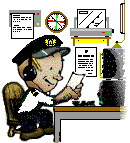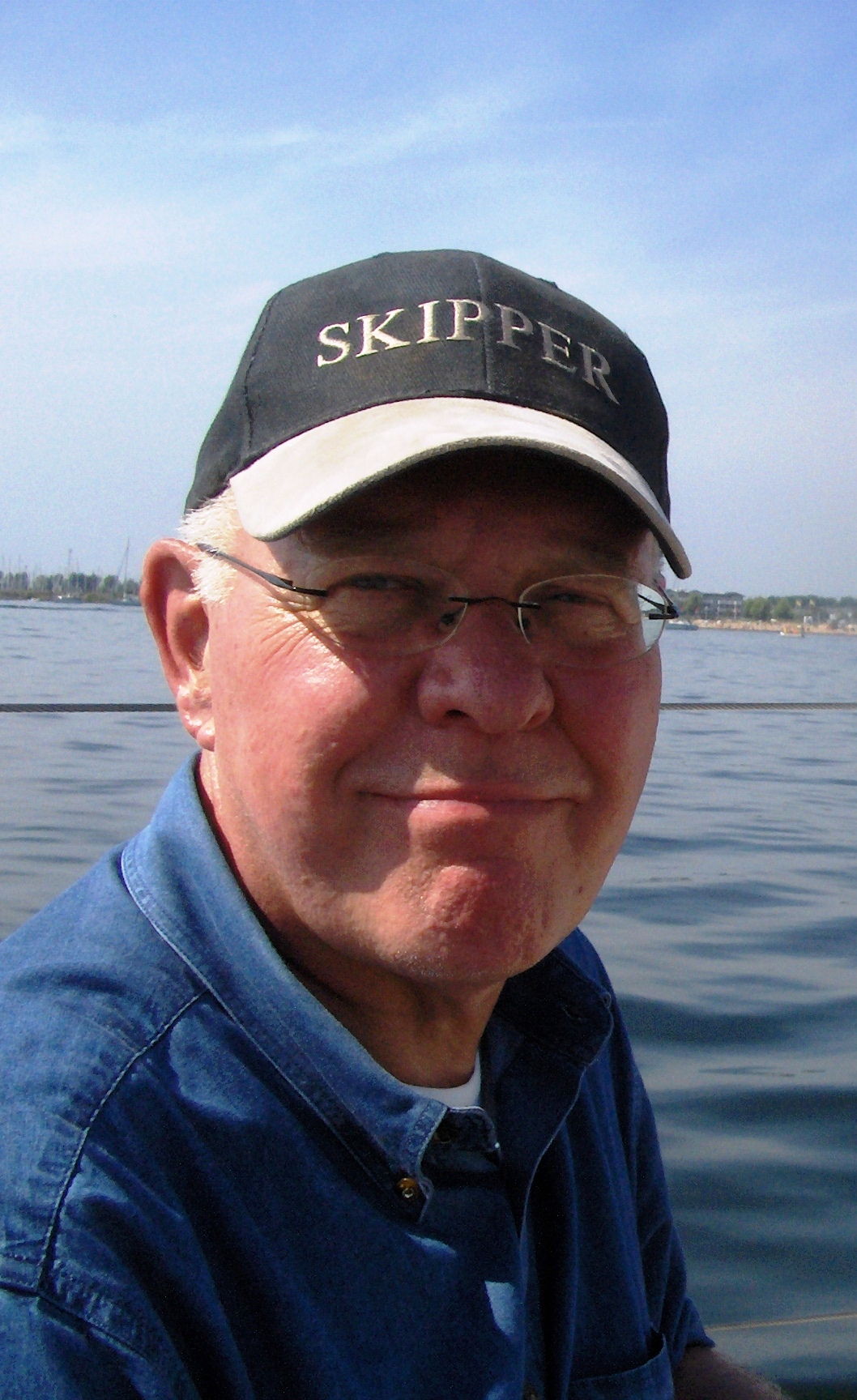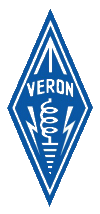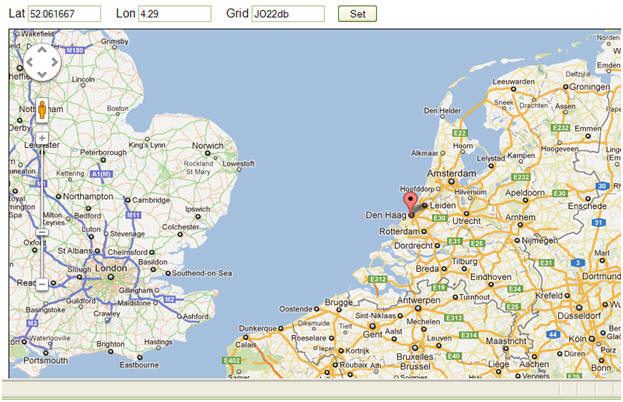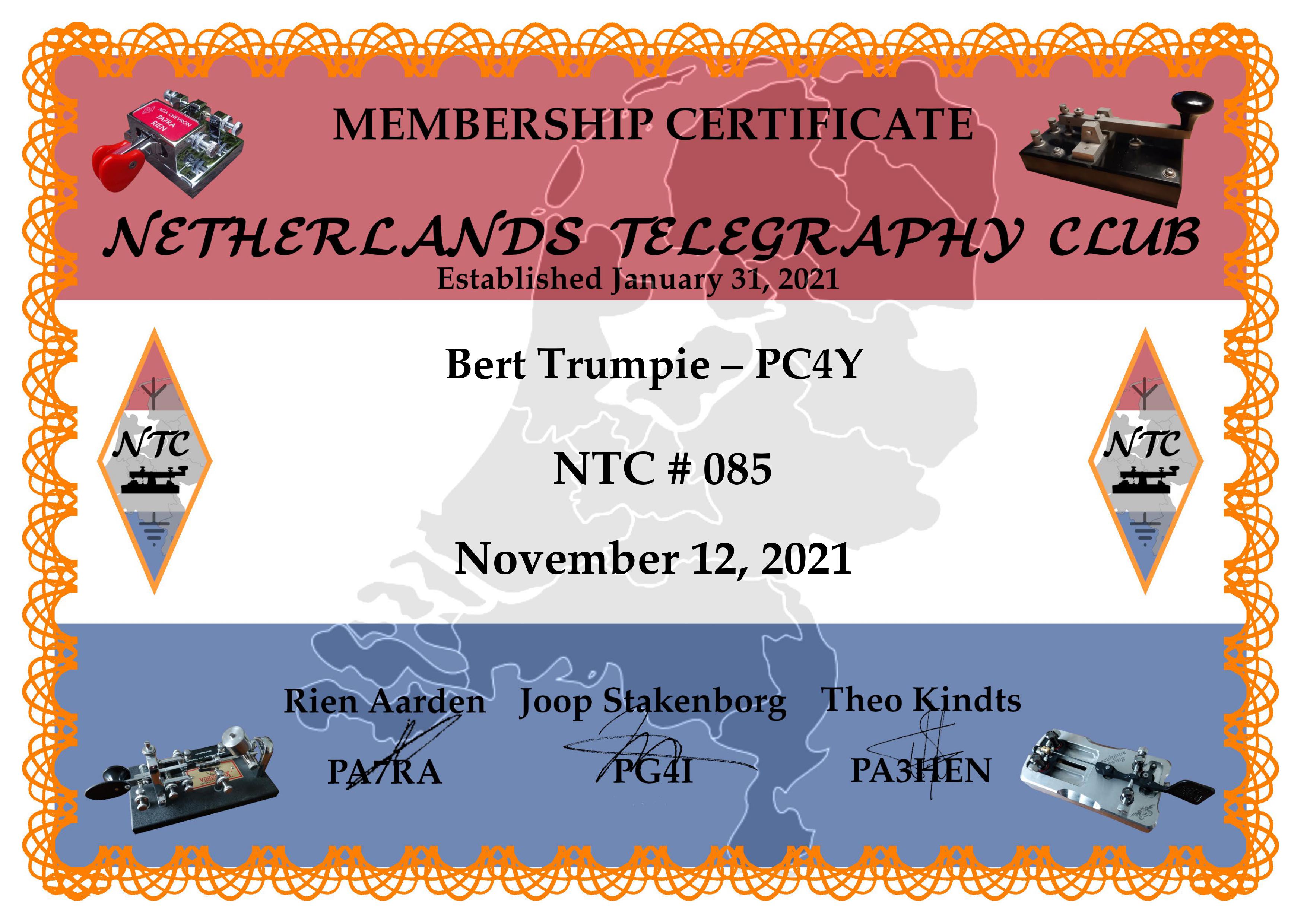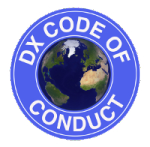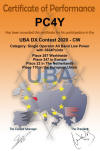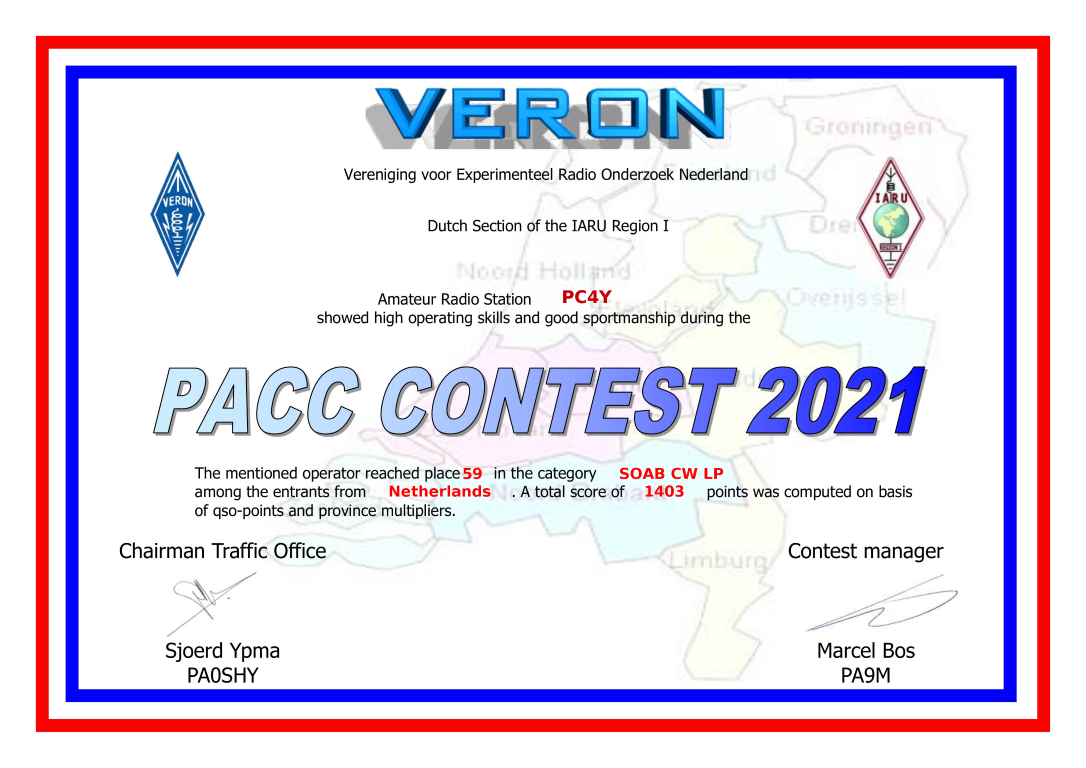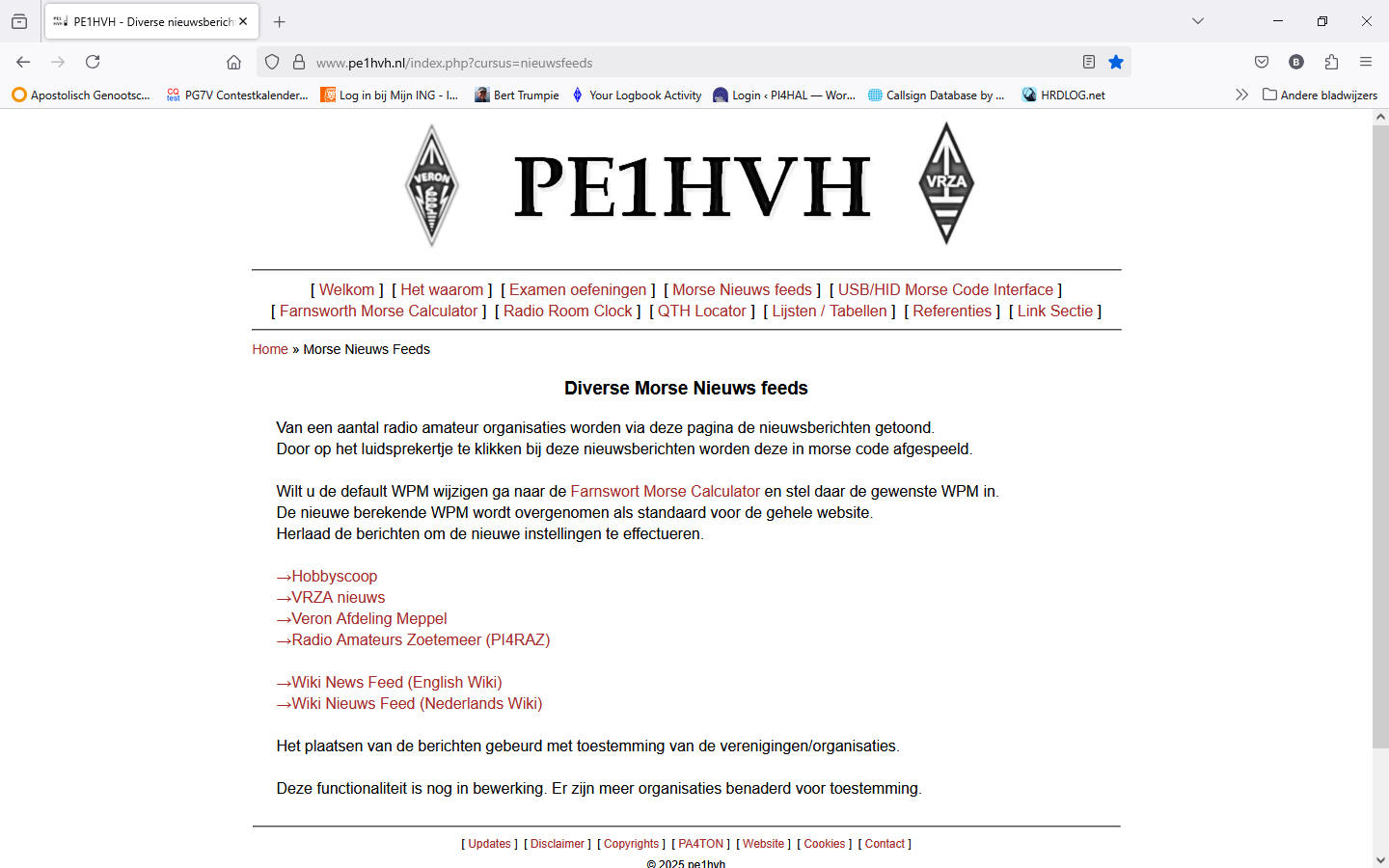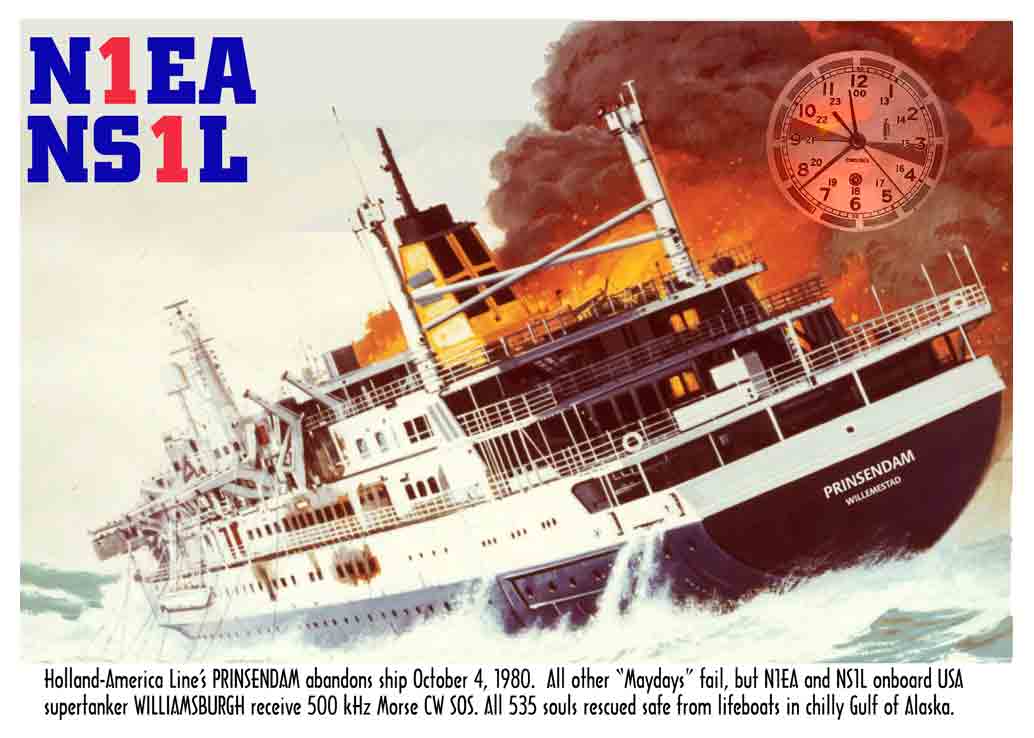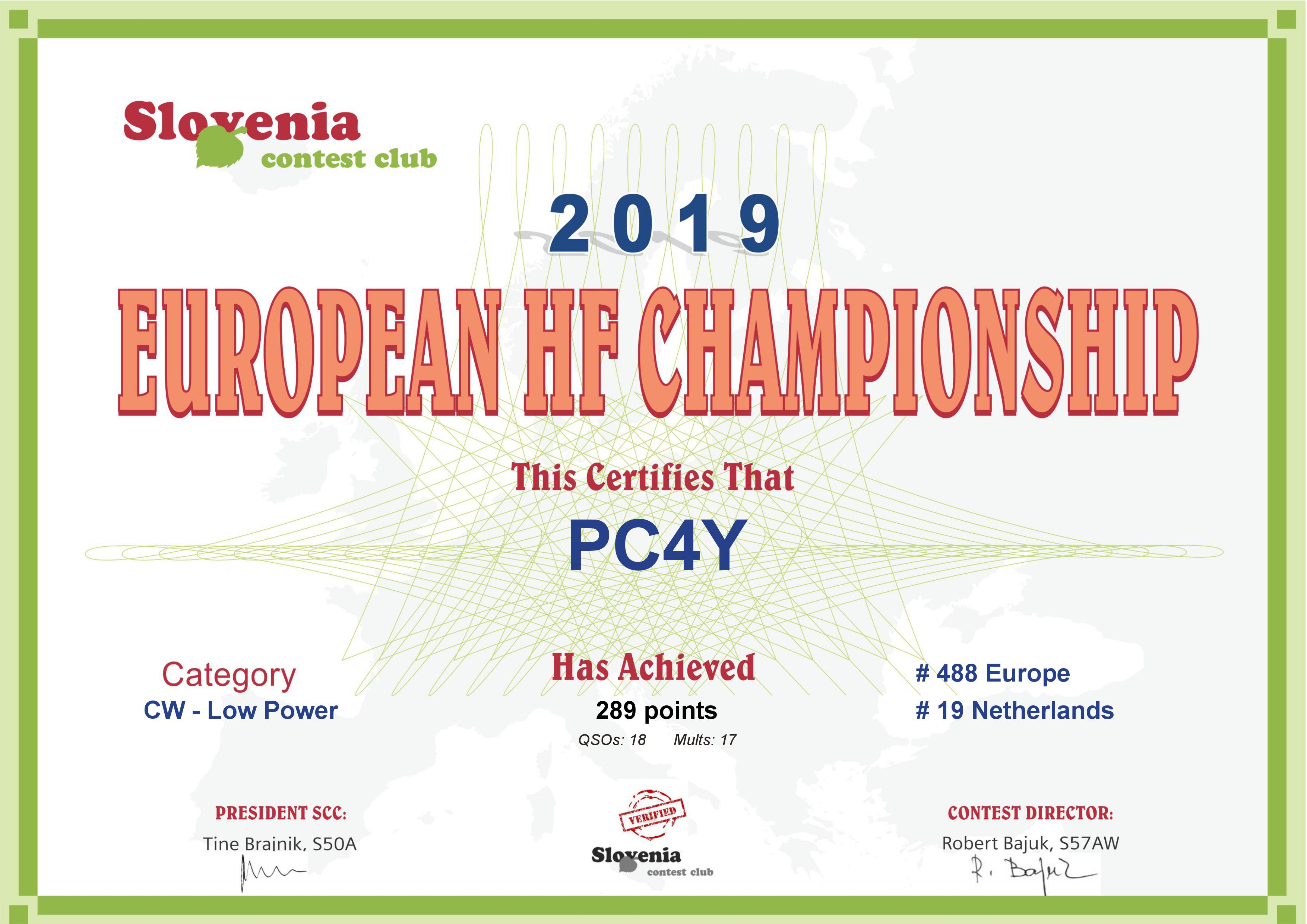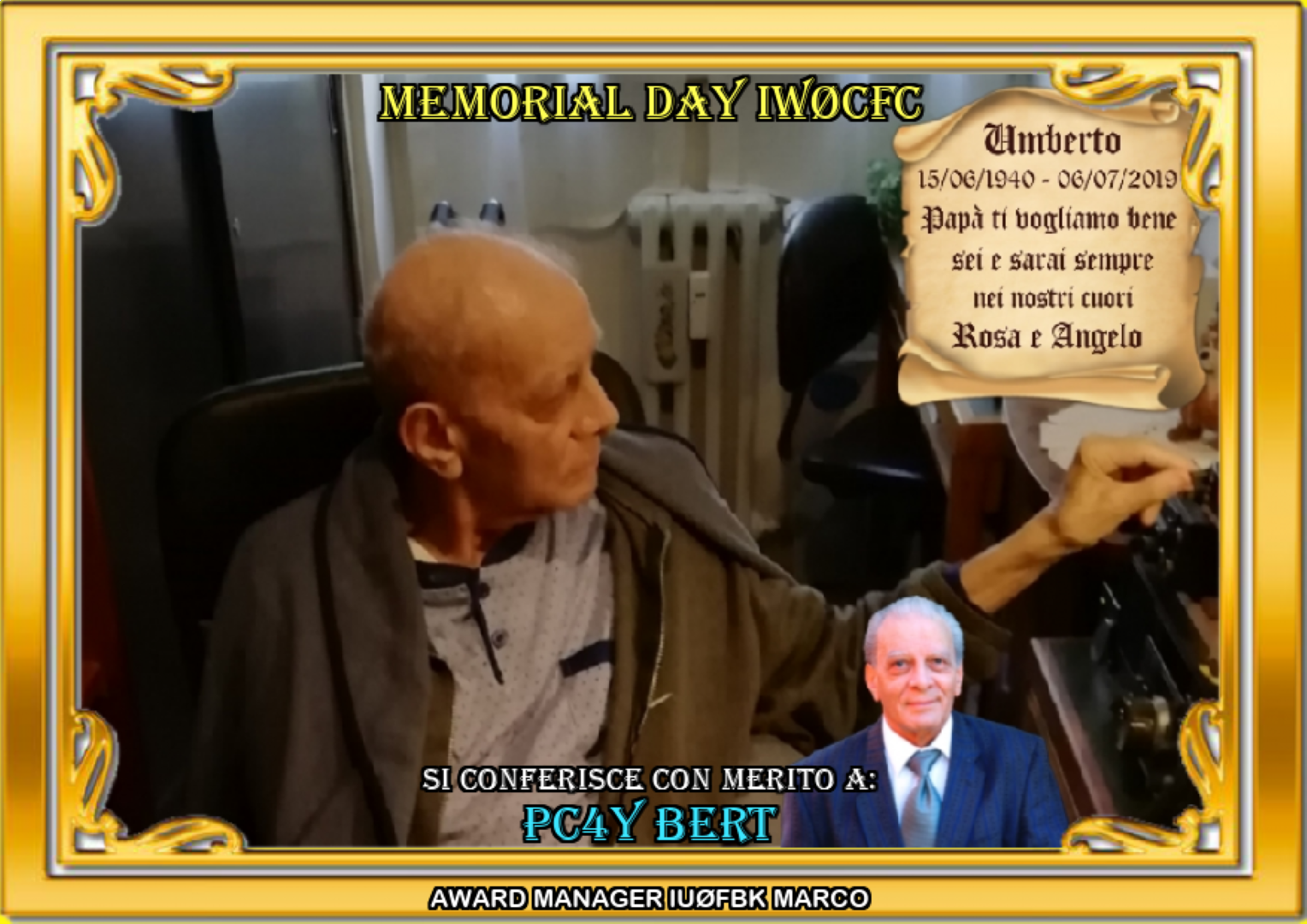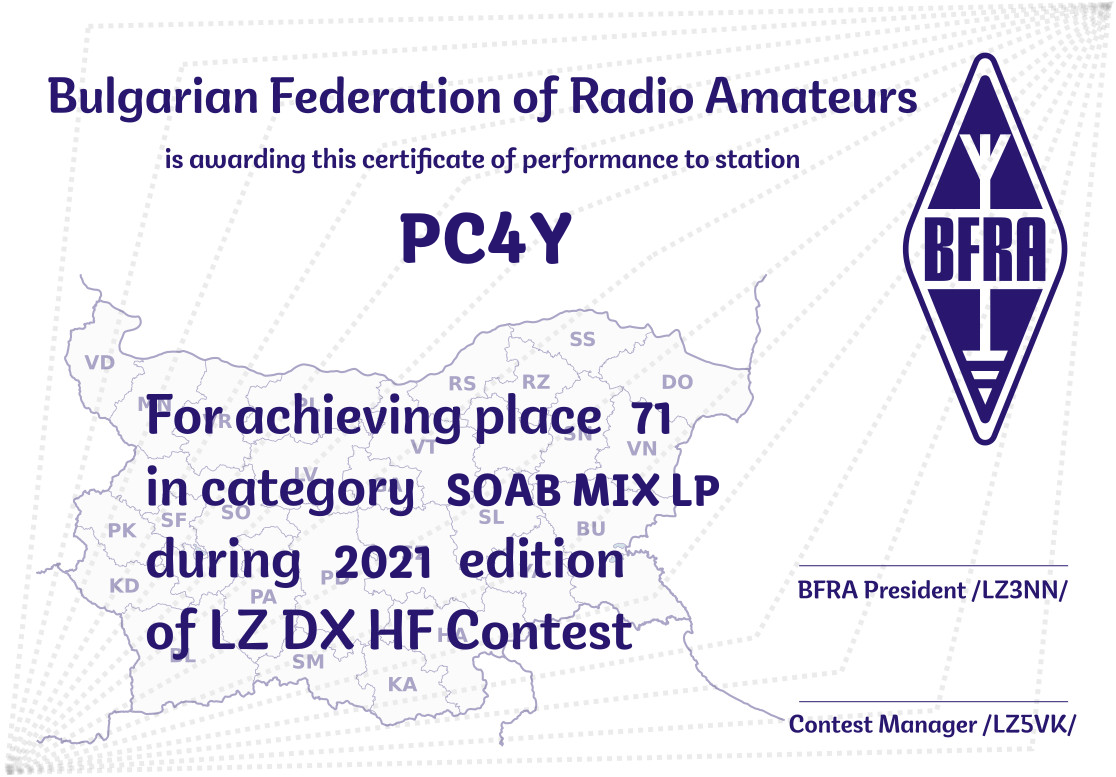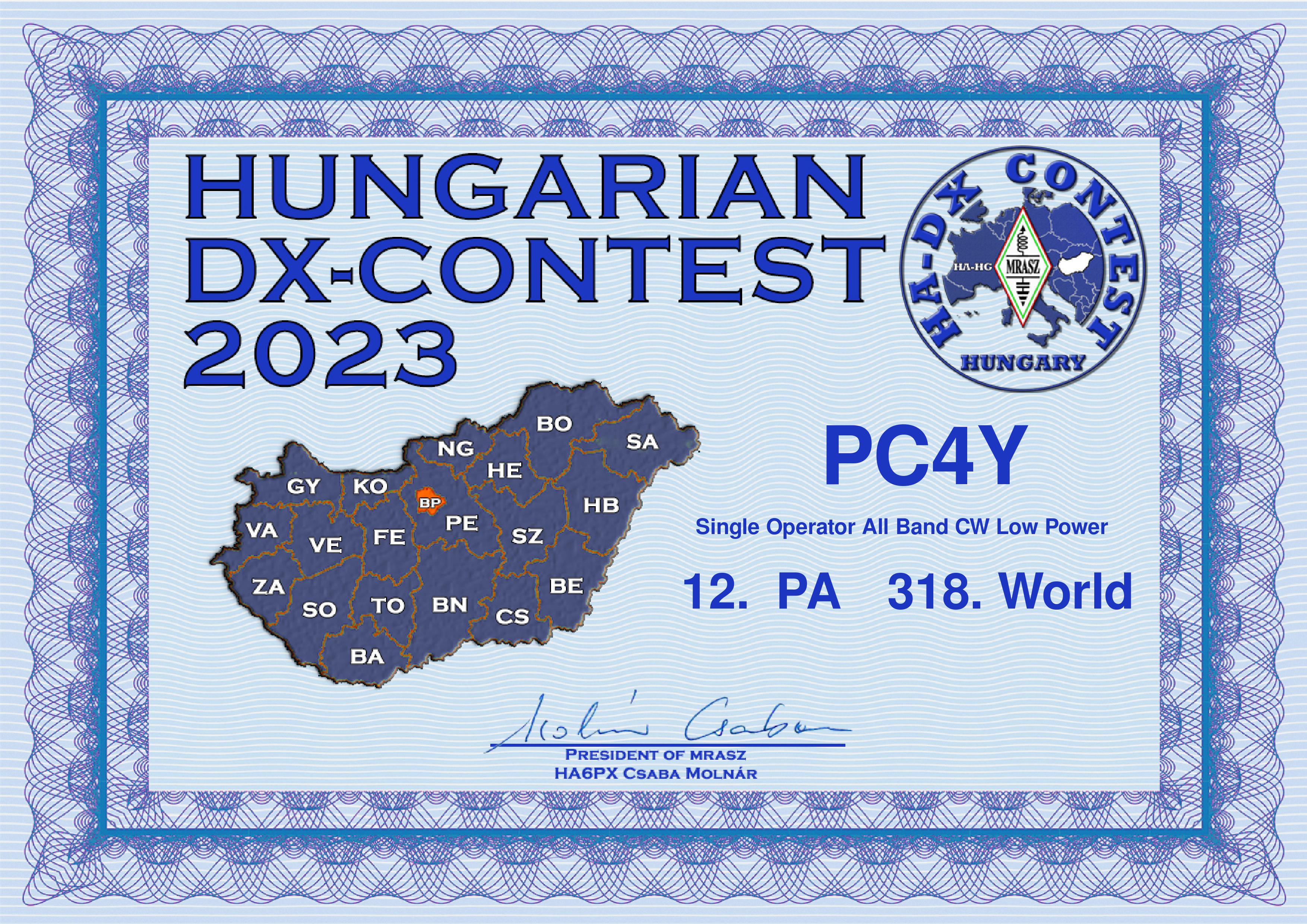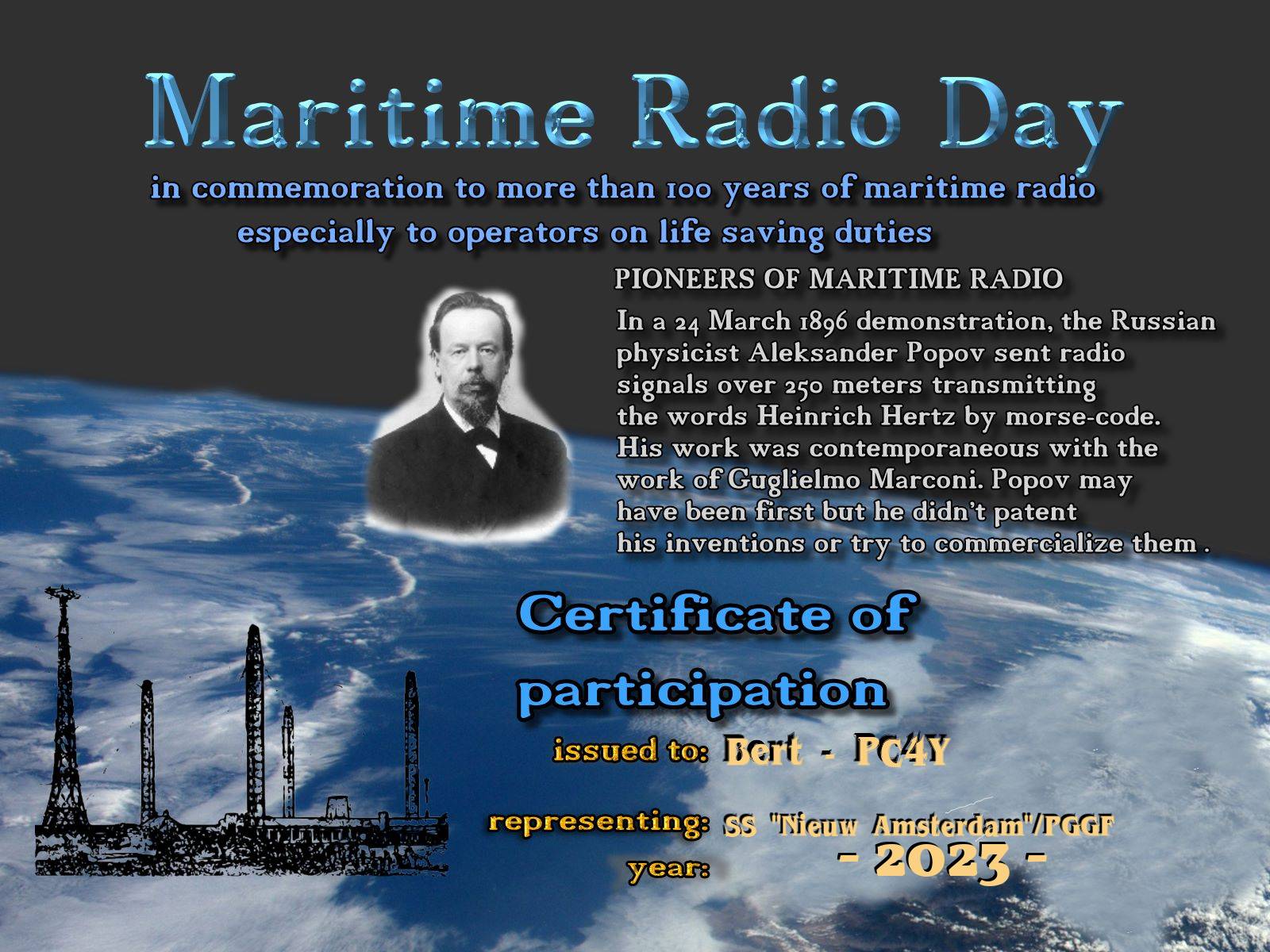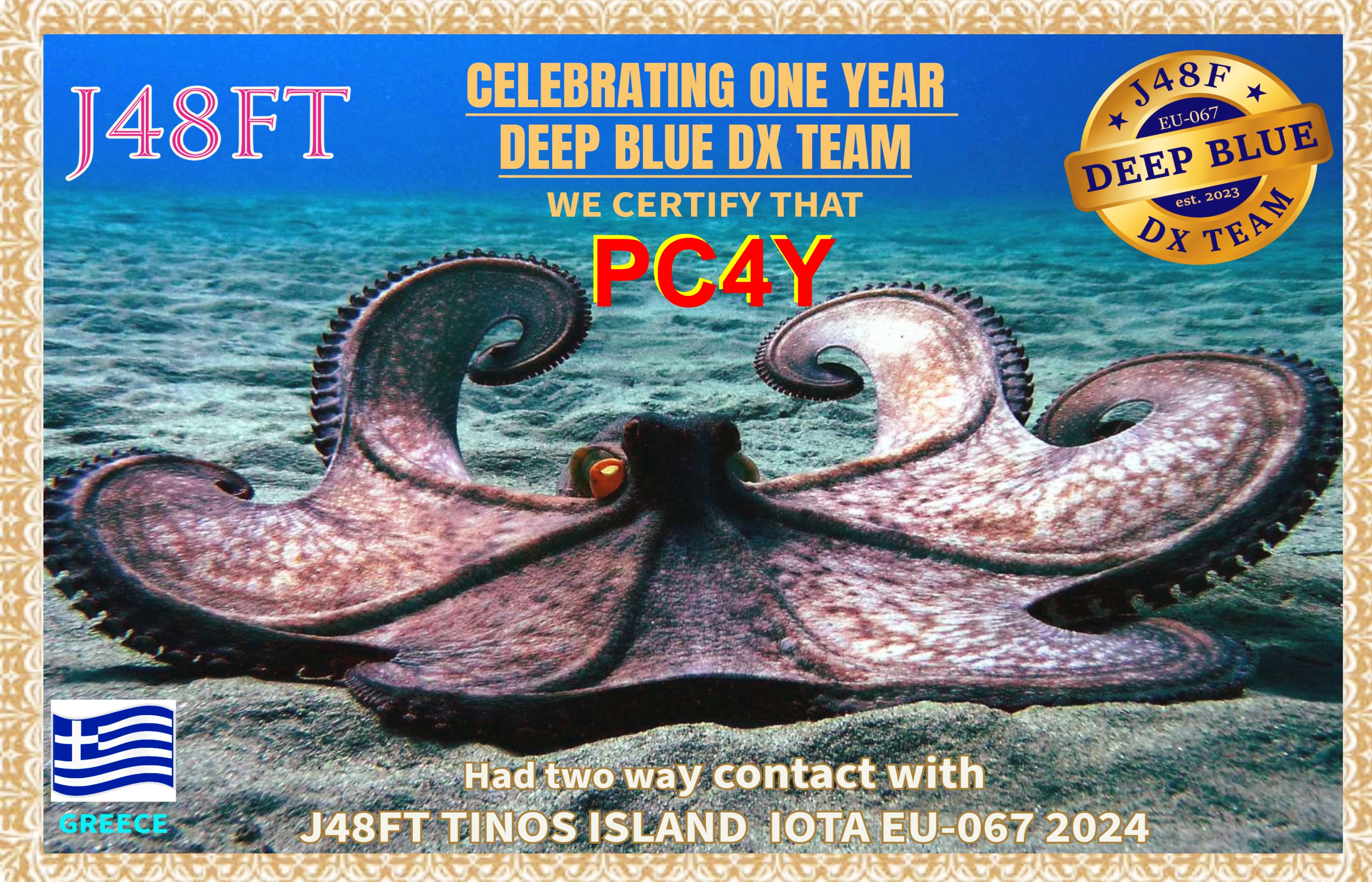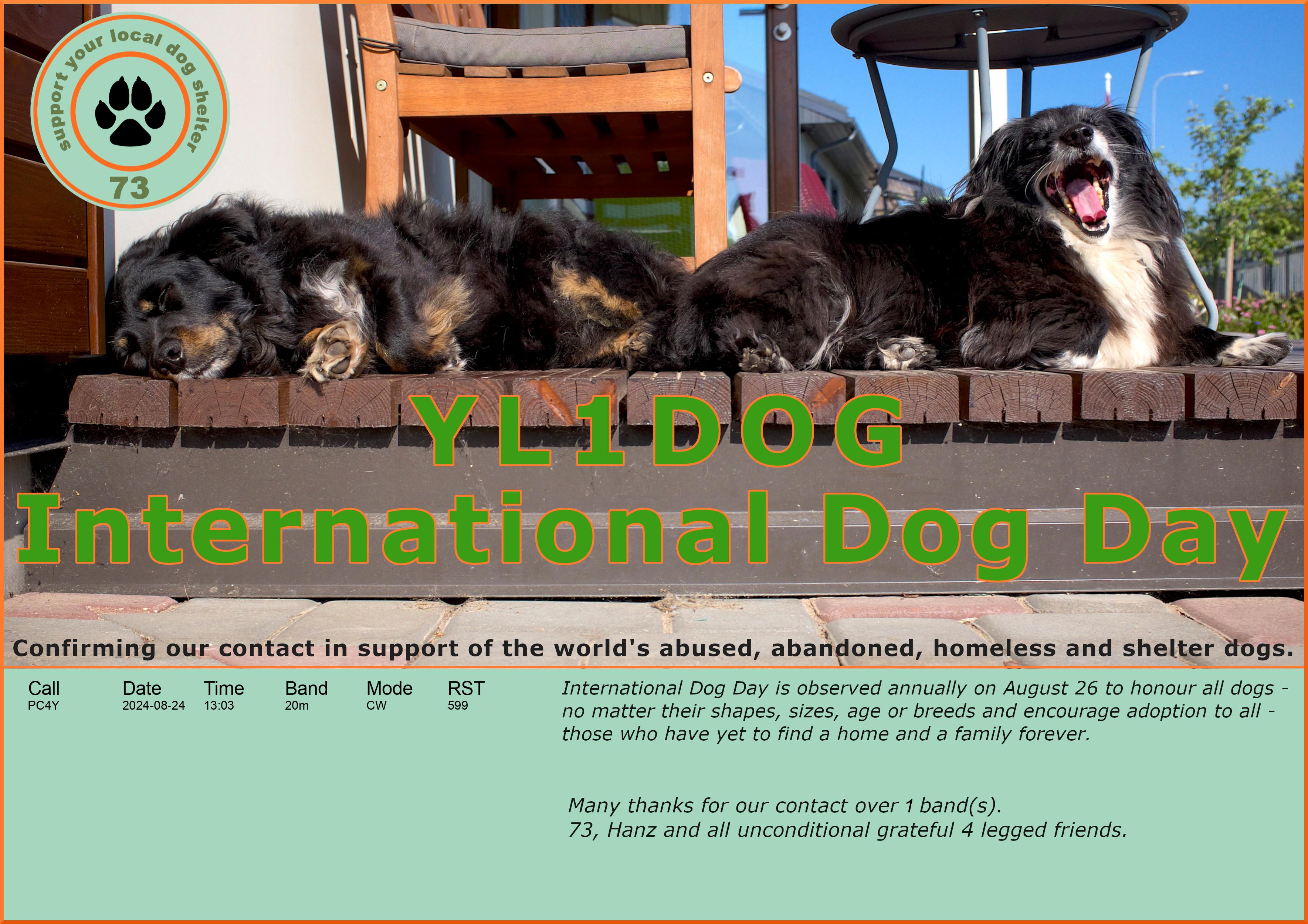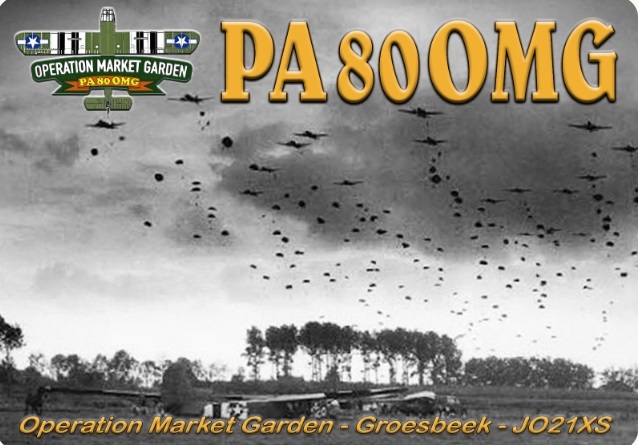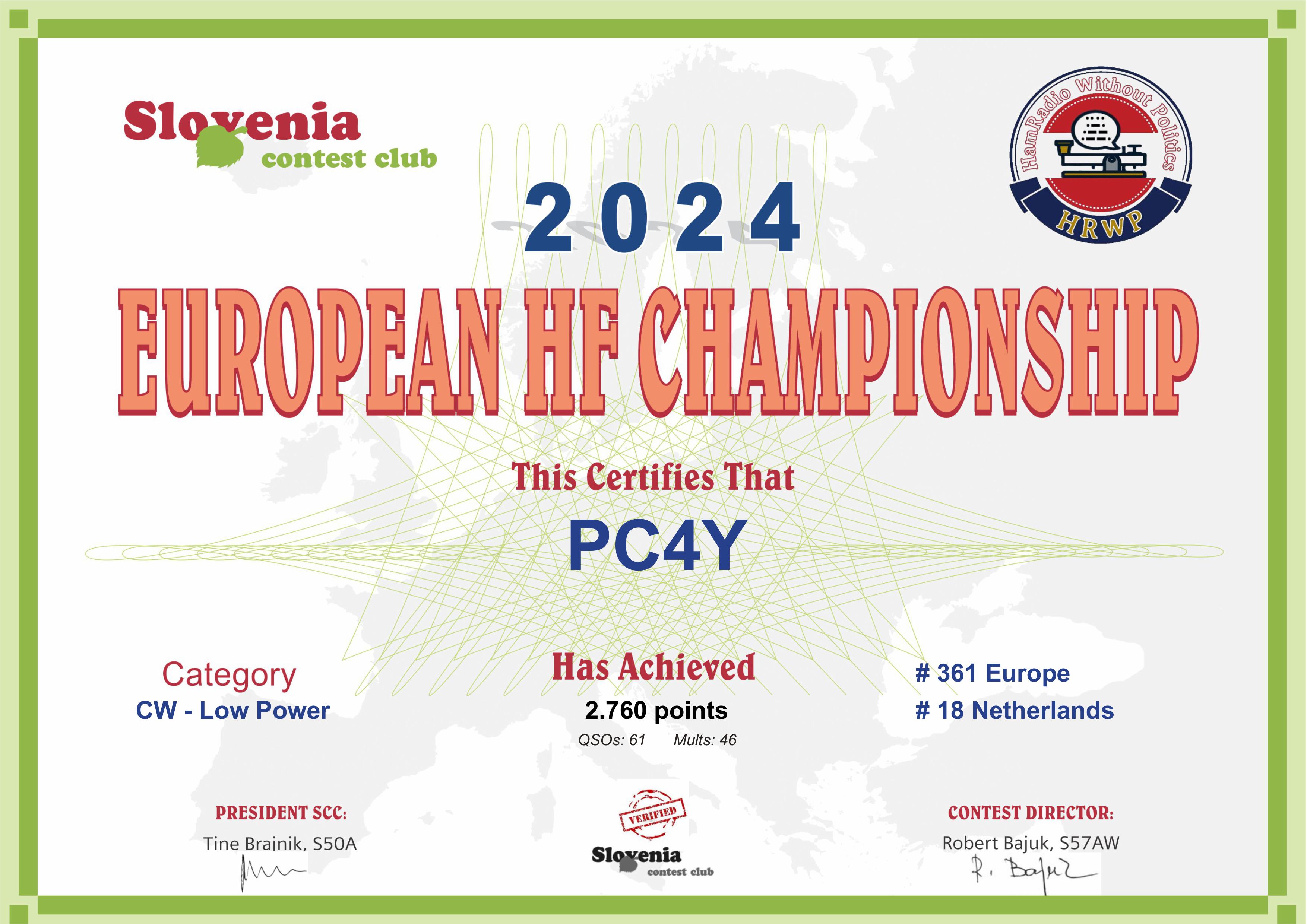|

Glossary of terms
of the above Solar-Terrestrial Data. In brief: High SFI (> 100) and
low K (< 4) are providing for good HF DX conditions.

Number of countries
(entities) worked
My career started as a
wireless officer.
I have done that from 1965 - 1974, serving on
board freighters and passenger liners like the s/s Statendam and the
(old) s/s Nieuw Amsterdam. So 'wireless' is rather familiar.
I did my N exam in 2011. My call sign then was
PD3TRU.
The first QSO with my legacy and
vintage YAESU FT-7 was
on april 23rd 2011 at 09:15 UTC with
F8CSL. A memorable
day to reach the middle of France with only 10 Watts in the antenna.
It was my first QSO after I stopped being a 'sparks' 37 years ago. A
true adrenaline boost.
On
March 5th 2014 I successfully
passed my F exam. From here on my call sign is
PC4Y. I have chosen PC4Y for a reason: my first ship I
worked on as an independent R/O was the KNSM
m/v ATTIS with call
sign PCVY. For nostalgia reasons I just added one dot
to the V and made it a 4 in CW language. The button below gives access to
the F study I did with the help of the VERON ham
radio club and the very useful help from
PA0WV.


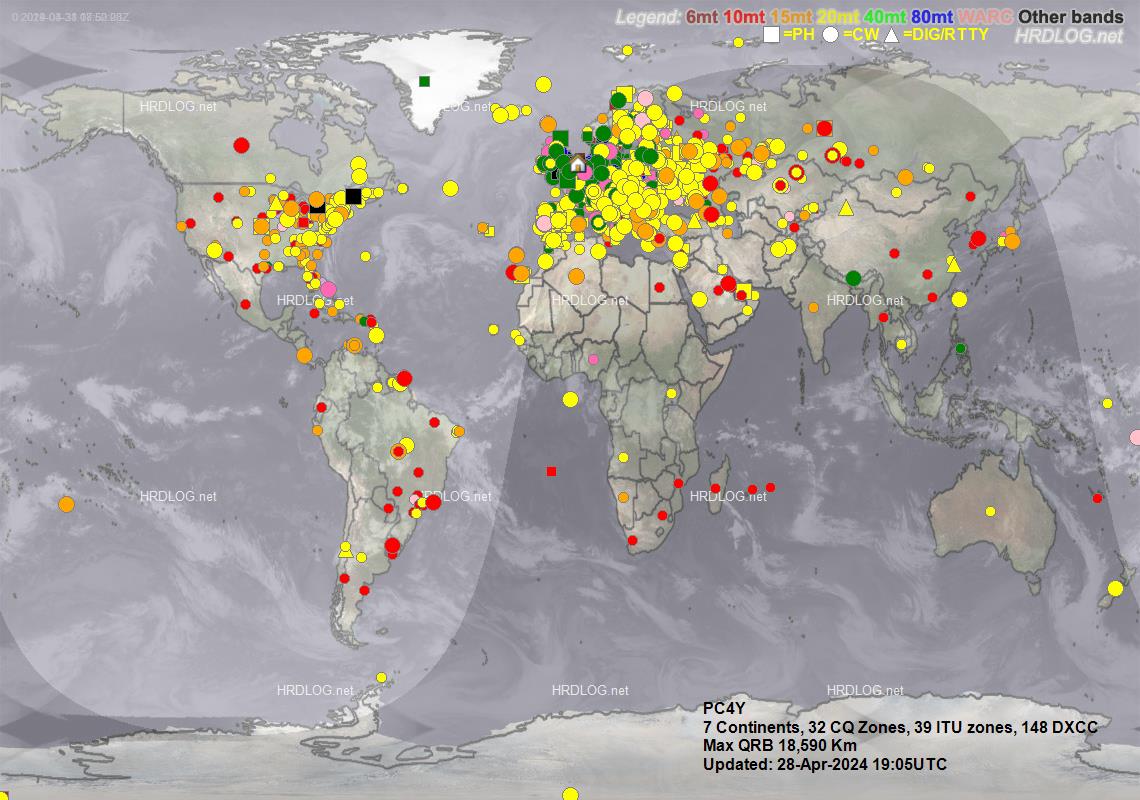
Some four or five spots in the above map are
incorrect, like the one in Alaska and the one in
the Gulf of Guinea. Apparently these guys have
their coordinates incorrect in their profile. It didn't help to adjust their locator coordinates
afterwards.
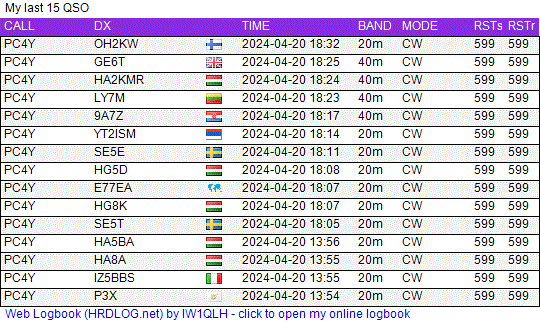
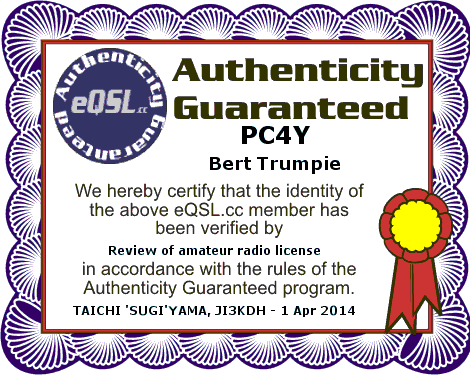

Clicking on the above button gives access to a series of
interesting
HAM Radio topics and answers from Dave Kesler KE0OG
My logbook is updated in HamRadioDeLuxe with daily updates to LoTW,
QRZ.com, eQSL, HRDlog.net and QRZCQ. LoTW clearly gives the most QSL's but no
QSL cards. eQSL gives nice electronic QSL cards and QRZ.com
is giving disappointing results w.r.t. QSL's. Some figures: On 1
March 2017 I have made 5169 QSO's from both the PD3TRU
and PC4Y call signs. I received 1692 QSL's from LoTW (32,7%),
1465 eQSL cards (28,4%) and 966 confirmed QSO's from
QRZ.com (18%).
|
Latest
days now on top as per request from many visitors
☺ And
only the last 12 months or so are published. Older data is
removed. |
Saturday 3 January 2026. Joined the PMC contest as
peace message exchanges are essential in these cumbersome times of
wars and conflicts worldwide. Only 17 QSO's. Unfortunately the PMC
contest and the MCD contest were causing some conflicts here and
there. See map below for the visual:
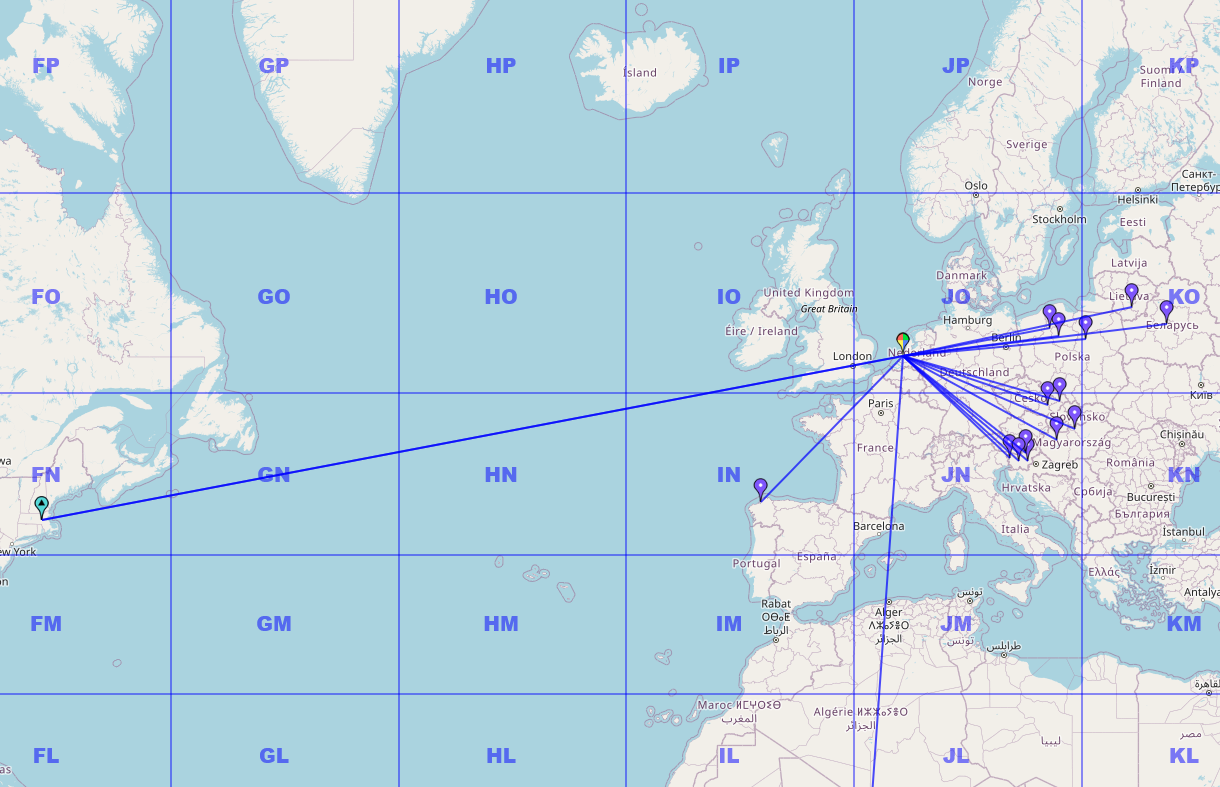
Weekend 20/21 December 2025. Joined the 9A Croatian
CW contest and worked all the bands except 80 and 160 meter. See map
below. Amazingly no QSO's to the West. Total of 64 QSO's.
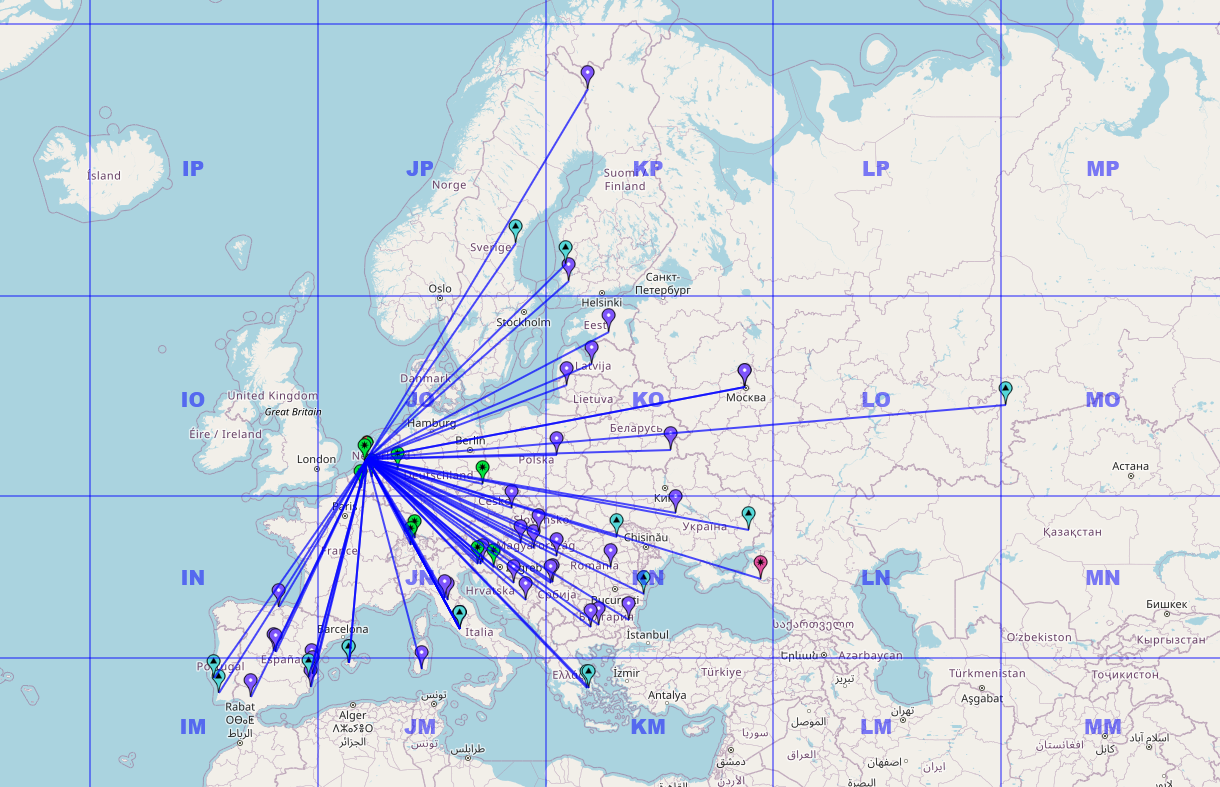
Wednesday 17 December 2925, A QSL card from the
past:
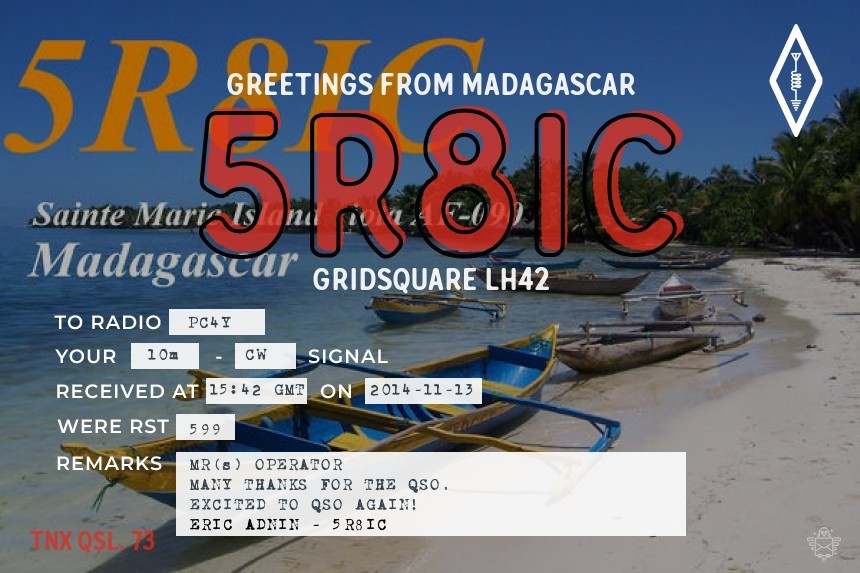
Saturday 13 December 2025. Joined the ARRL 10 meter
CW contest for a brief moment and made only 4 QSO's with the
US east coast. Busy in the band. In the previous days I made some
casual QSO's with random stations in the various bands. I have not
been doing that for some time for some reason.
Weekend 22/23 November 2025: The LZ DX contest!
Busy on the bands. I worked the 15, 20 and 40 meter bands and made
47 QSO's in about 60 minutes and then I called it quits. But it was
great fun! See map below. Mostly within Europe. Don't know why that
is. Click on the map for details.
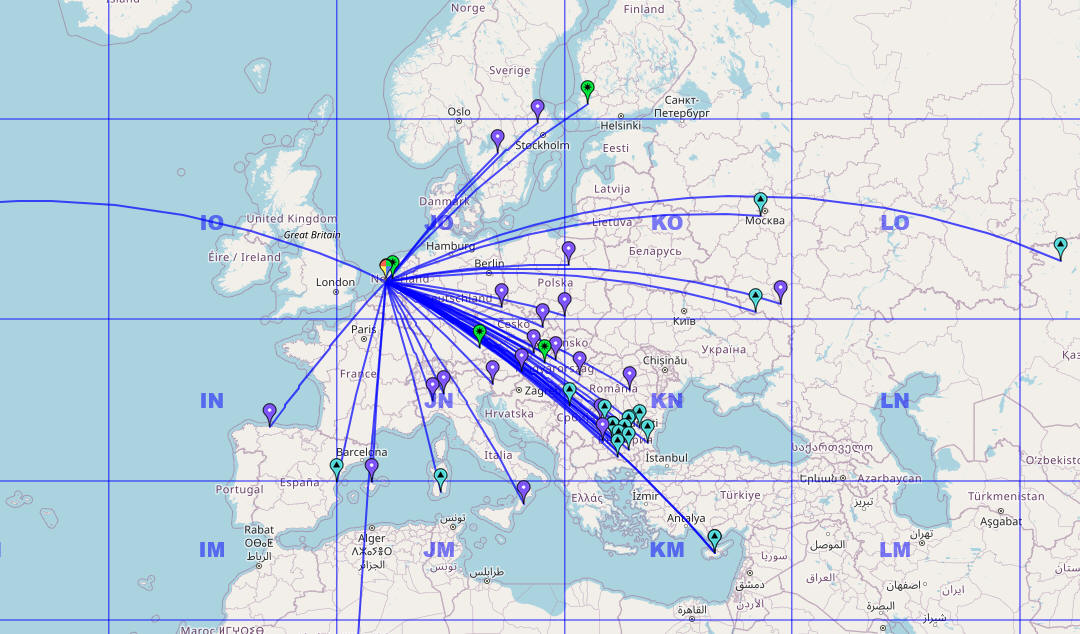
Saturday 8 November 2025. Joined the PA Beker CW
contest for 1.5 hrs and made 33 QSO's in de 40 meter band only.
Covered most of The Netherlands except South Limburg and the
northern islands. See map below.

The Worked All Germany (WAG) contest in October 2025:
| Callsign |
QSOs |
QSO-Pts |
Multi |
Result |
Weekend 27/28 September 2025. The Serbian YUDXCW
contest was nice to participate. Busy and fun. Made 30 QSO's only as
time was limited.

Weekend 23/24 August 2025. The YODXCW contest was a
busy event again. I joined and made 40 QSO's. Only one in de US, the
rest was mainly Europe. Worked the 40, 20 and 15 meter bands.
Thursday 21 August 2025. Joined the NTCQP (QSO
Party) at 1900 zulu. Only made 6 QSO's in de 40 meter band. Heard no
one in the 80 meter band.
aturday 2 August 2025: Joined the EUHFCW contest
between other activities. Made 33 QSO's. It was busy in the bands.
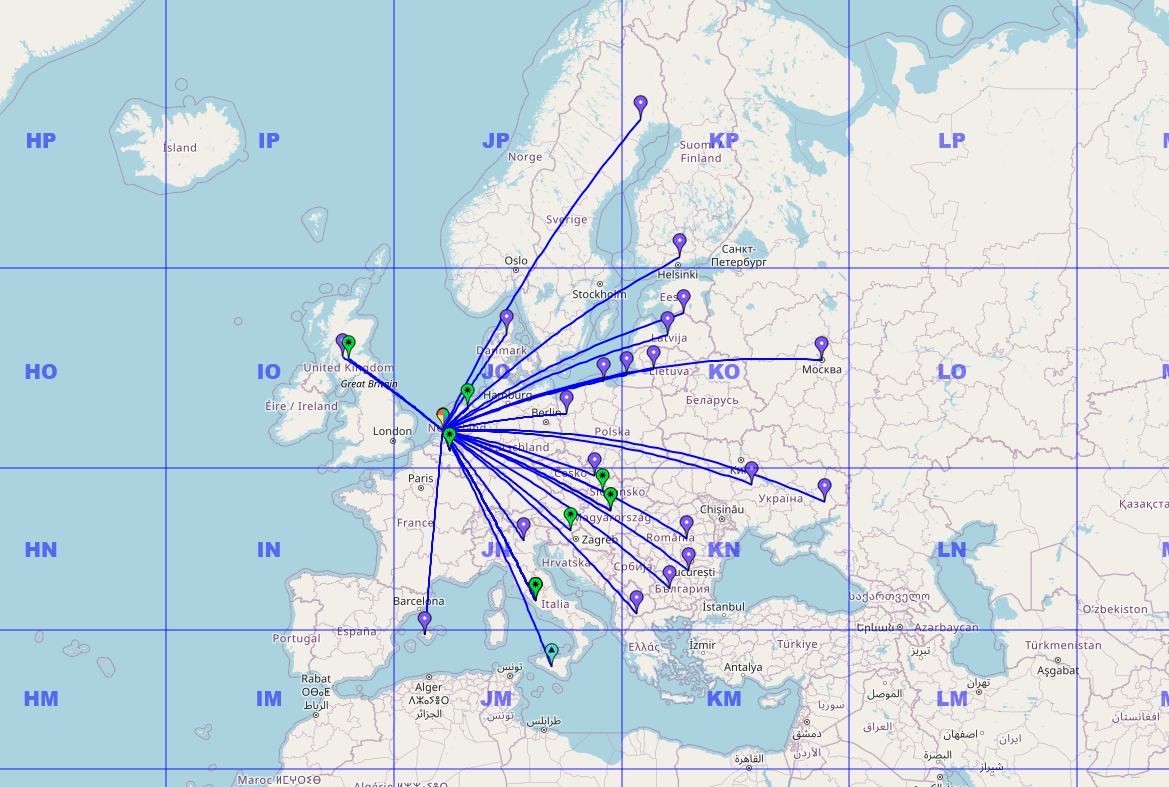
Weekend 12/13 July 2025. Joined the IARU HF CW
contest. Made 44 QSO's. Only Europe and some Asia. Nothing in the
West.
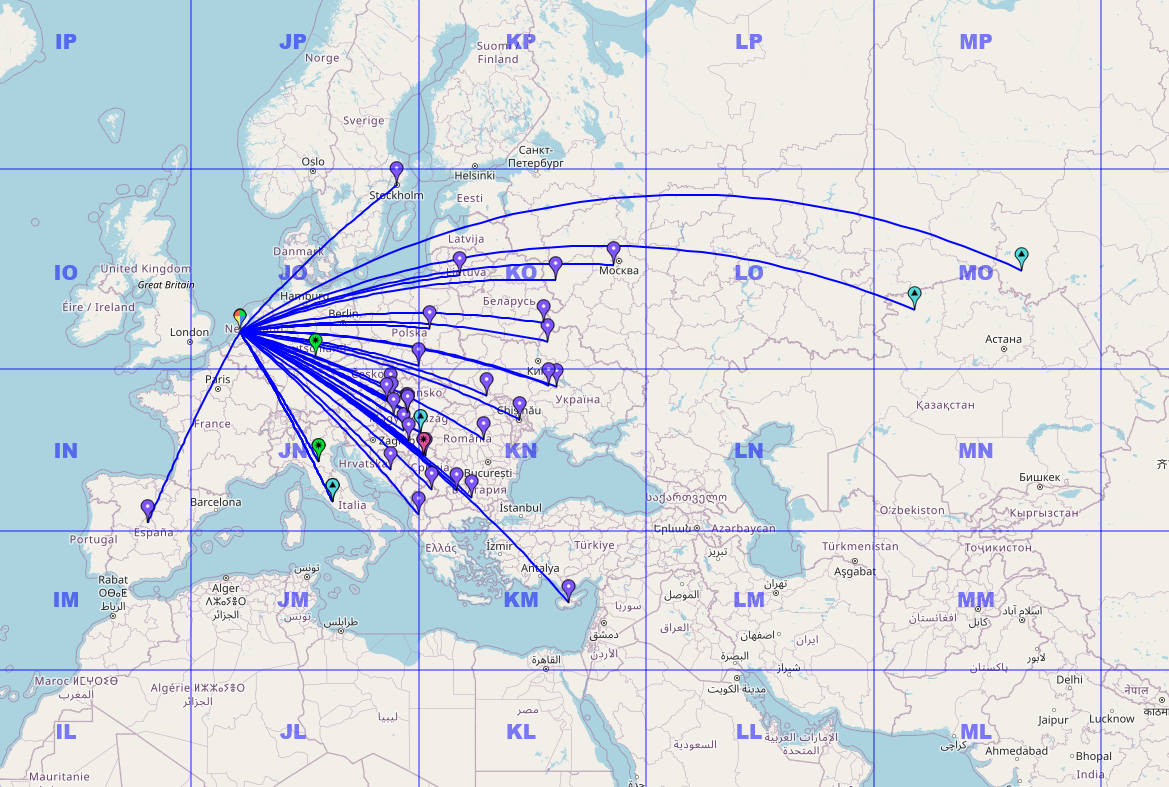
Weekend 5/6 July. The infamous MMC contest. In CW.
Worked for some time and made 30 QSO's. My first contest in 6 months
time. Worked Europe only. Heard Canada and the US nonetheless.
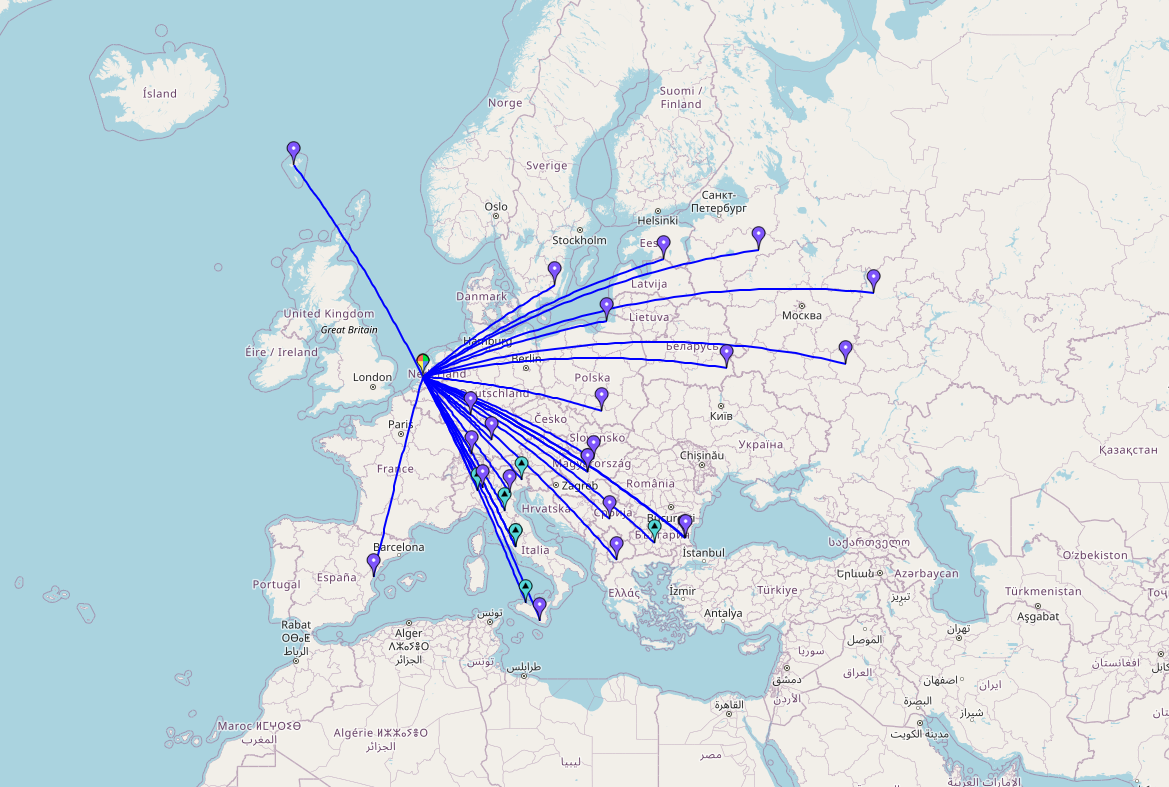
Sunday 29 June 2025. Contacted PA80PEUJ as they
were celebrating the 80th anniversary of the first QSO with
Scheveningen Radio / PCH after the end of WWII. So obviously
we exchanged the good old-fashioned QTC's (telegrams). It was fun.
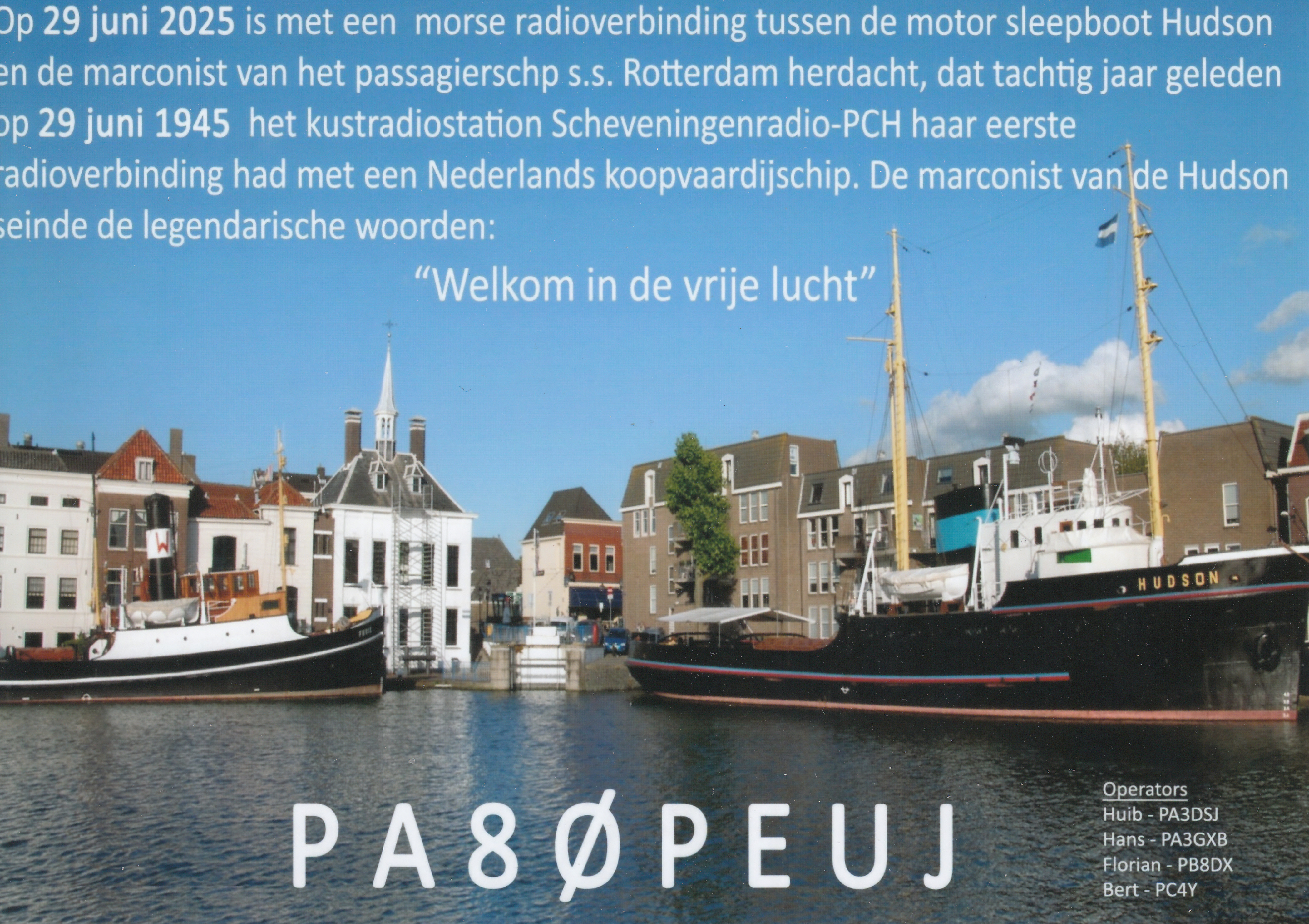
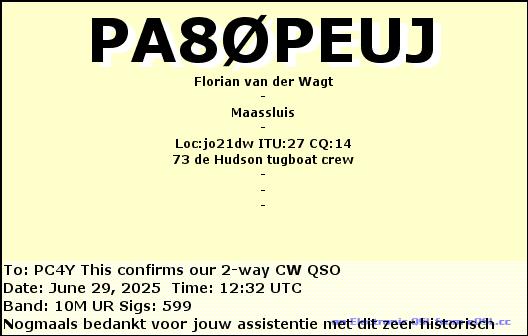
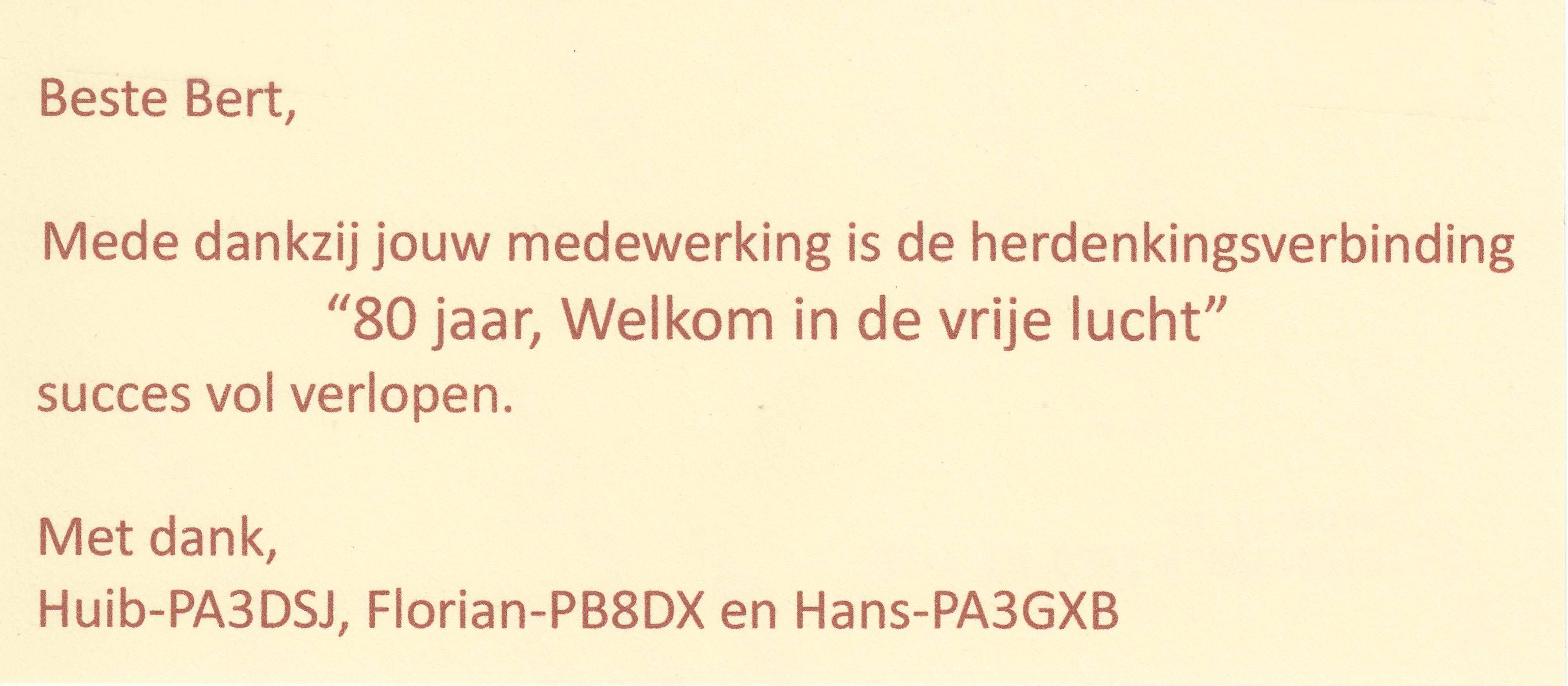
Monday 26 May 2025. It has been a while. My
recovery from a total hip replacement and the bacterial infections
thereafter is taking much longer than I had thought. This resulted
in a lack of interest or energy to work the radio. But yesterday I
worked PA25BOTA in
both VHF and HF. And also
PA75OTC on HF. So I guess it is gradually coming back. I sure
hope so.
Wednesday 2 April 2025. Received a nice QSL card
from the past:
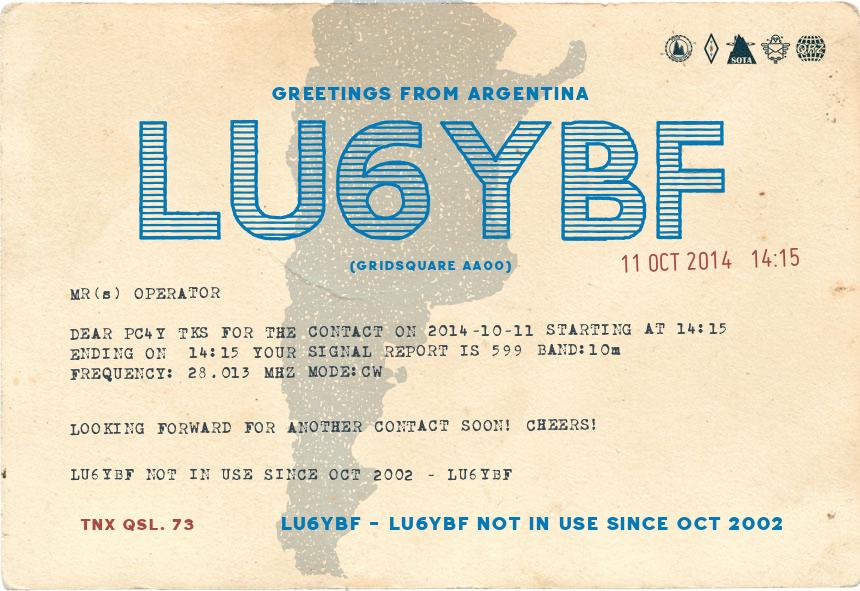
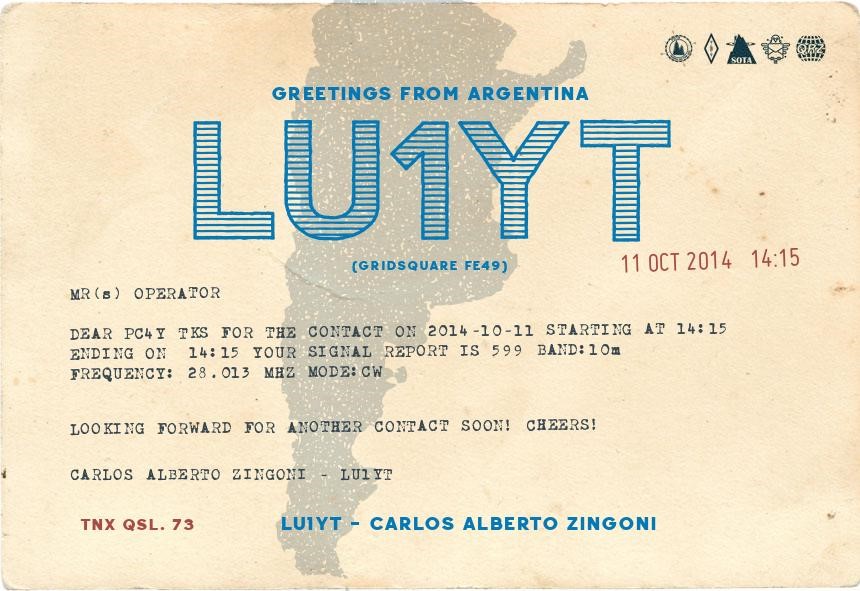
Monday 24 March 2025. Unfortunately my hip
replacement has been causing problems. The wound got infected by a
bacteria and I underwent a new operation (twice) to clean the wound
and a partial replacement of the prosthesis. I am still on heavy
medication and recovering from the infection so I have not been very
active with the hobby.
Wednesday 12 February 2025. It has been quiet for
some time. I underwent a hip replacement, so I am recovering from
this operation. It would have been a good period for the radio
hobby, but Murphy came along resulting in a non working HF system.
The special provision the allow the coax cables to pass the window
turned out to be too weak, resulting in a break in the cable
throughput. But as I was kind of disabled during the recovering of
my hip operation I couldn't fix the problem. In the mean time I have
as per today fixed it by using short RG58 cables to pass through the
window. So my HF is working again and I will be on the air shortly.
Weekend 18/19 January 2025: Joined the HA DX
contest and worked the 10, 15, 20 and 40 meter bands. In total I
have spent approx. 2 hours and made 60 QSO's. It was crowded in the
bands which is nice. It was fun again. See map below and click on it
for more details.
|
Evaluation category |
QSOs |
Points |
Multipliers |
Claimed
score |
|
Single
Operator All Band CW Low Power |
60 |
300 |
42 |
12600 |
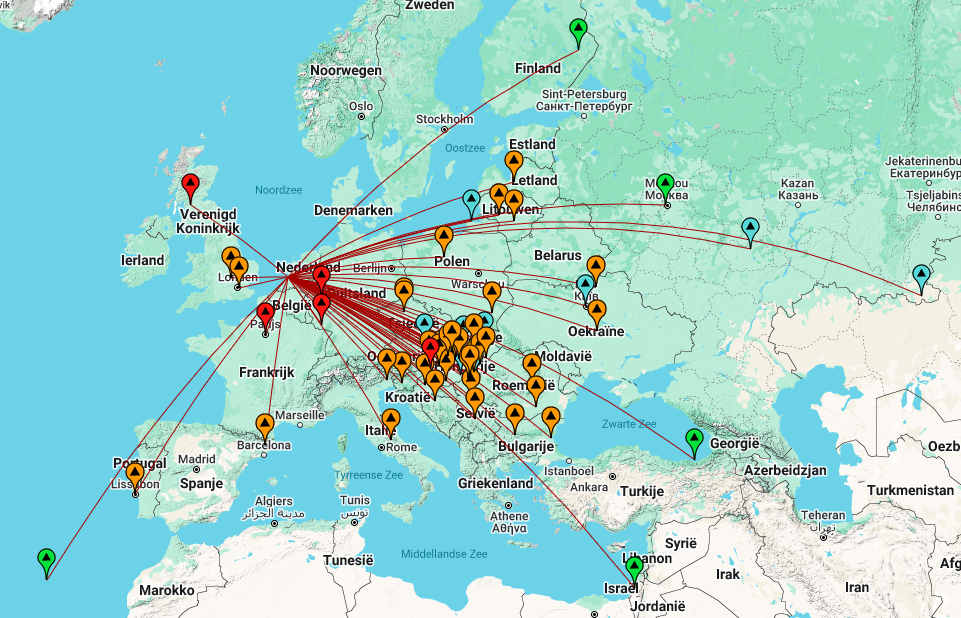
Monday 13 January 2025. First of all: Happy New
Year. A bit late, I know. Sorry. Yesterday I joined the 10 meter
DARC contest, but a few participants said they only wanted to QSO
DARC stations. My information said it was 'everybody with
everybody'. So I quitted. But I had one QSO with St Helena
ZD7BG. Pity he doesn't
use LOTW. And I received a QSL card from RU4F: QSO on 3 September
2011 with my N license call PD3TRU. Made by QSL creator. Nice, but
it makes me wonder.......
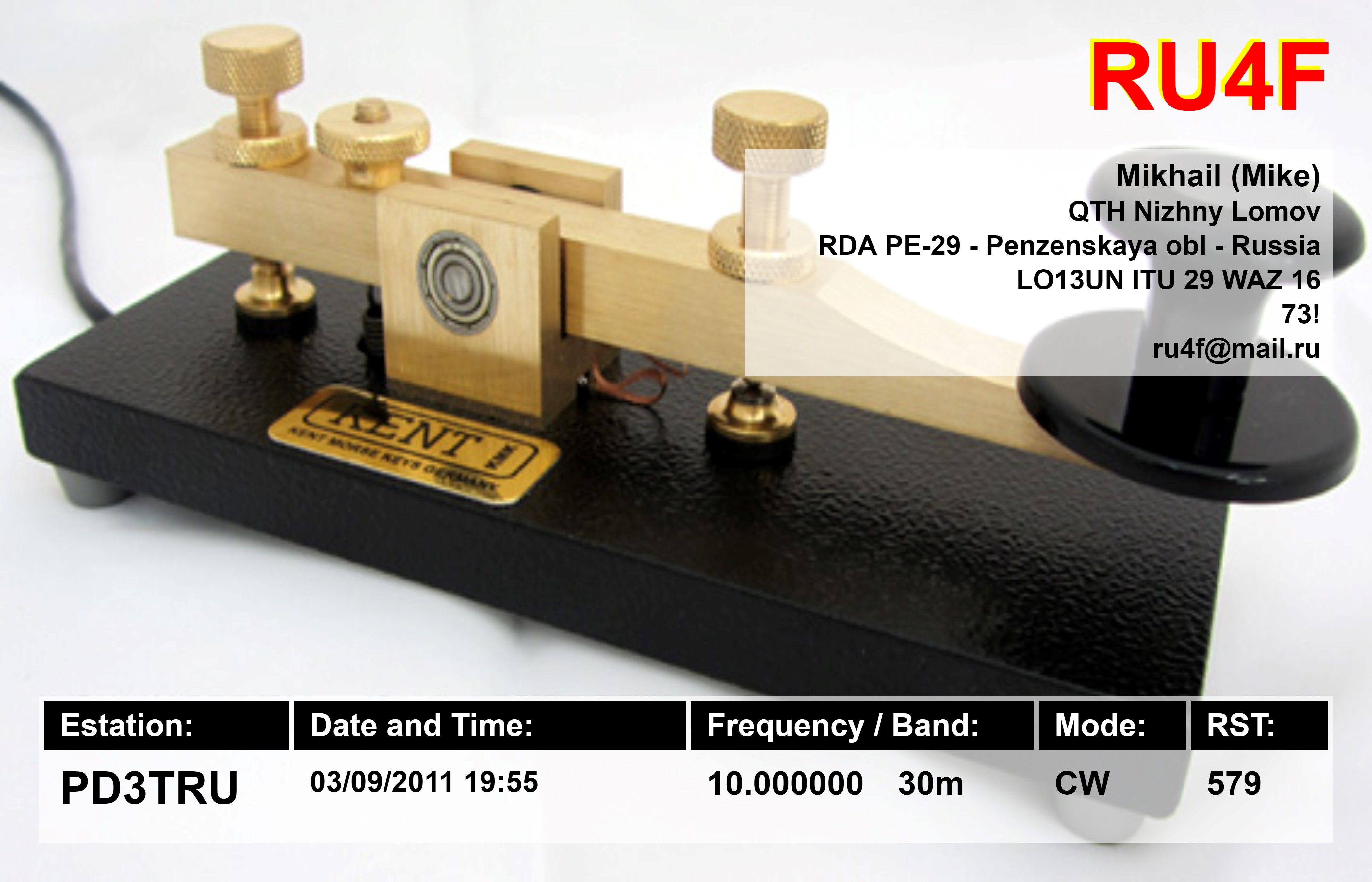
Thursday 19 December 2024. Joined the NTC QSO Party
from 19:00 till 20:00 zulu. The 40 and 80 meter bands were moderate
to poor unfortunately, but I received a nice QSL card from PF6SINT
and made 9 QSO's only
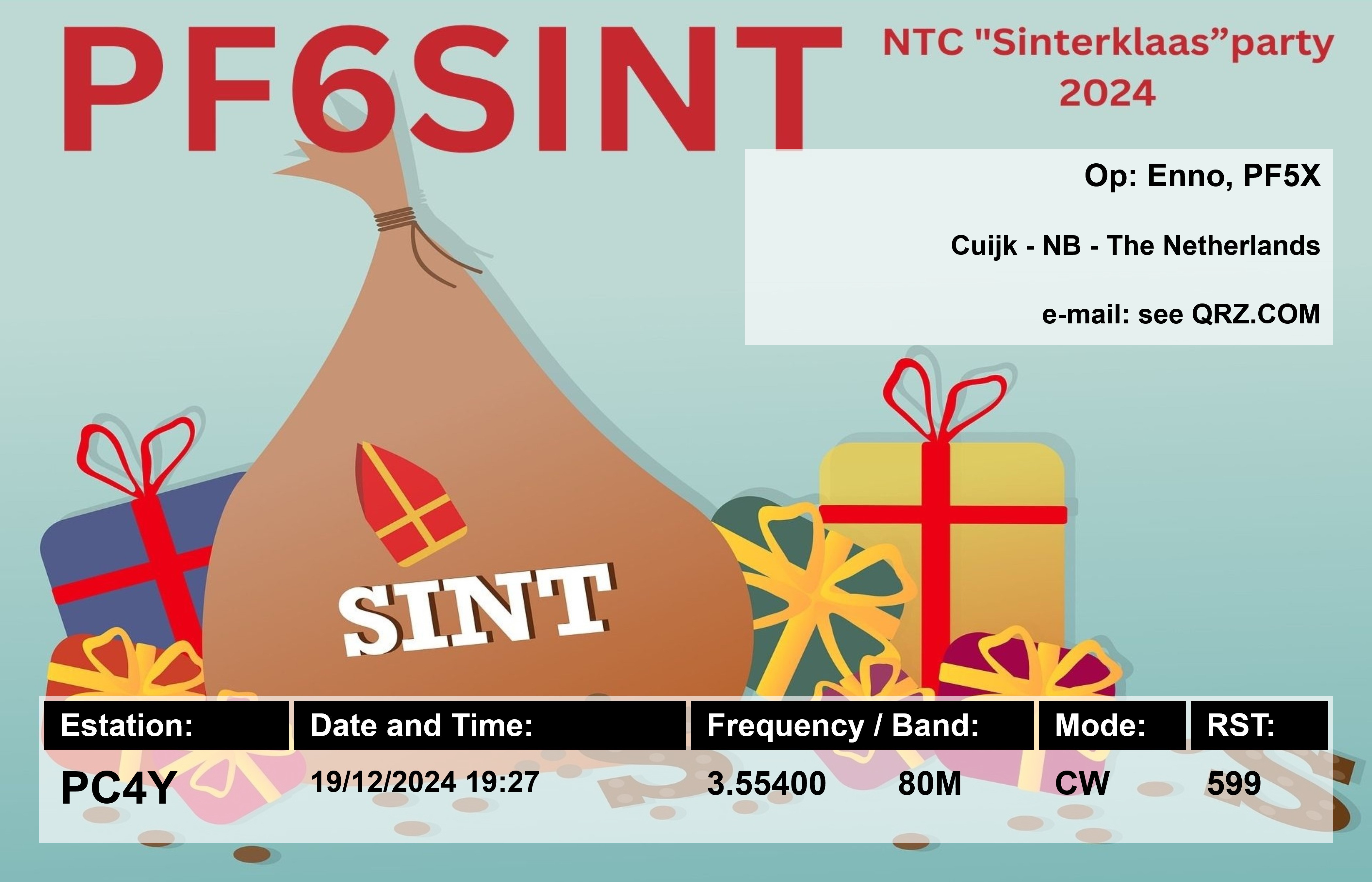
Weekend 14/15 December 2024: Joined the famous 10
meter band contest from ARRL. A quarter of an hour here and there
and made 50 QSO's including Nepal, Cape Verde and Argentine. Nepal
is a new DX for me. It was very busy in the band and it was great
fun.
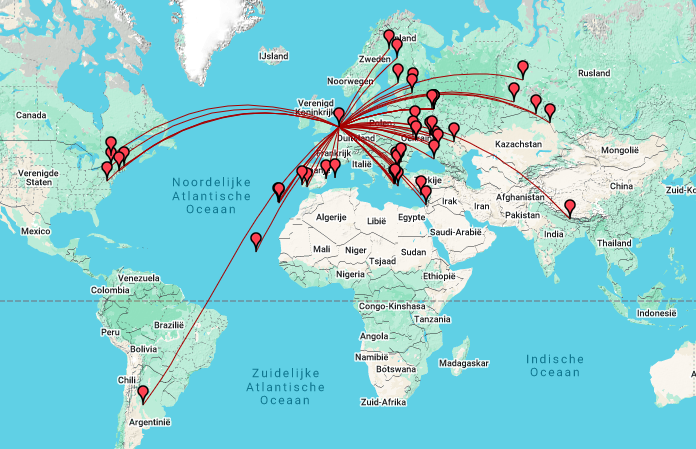
Friday 6 December 2024. Joined the Latvian Straight
Key contest using my Junker key. It was on the 80 meter band only
for which my setup is insufficient, but I made 3 QSO's nonetheless.
And received a beautiful certificate!
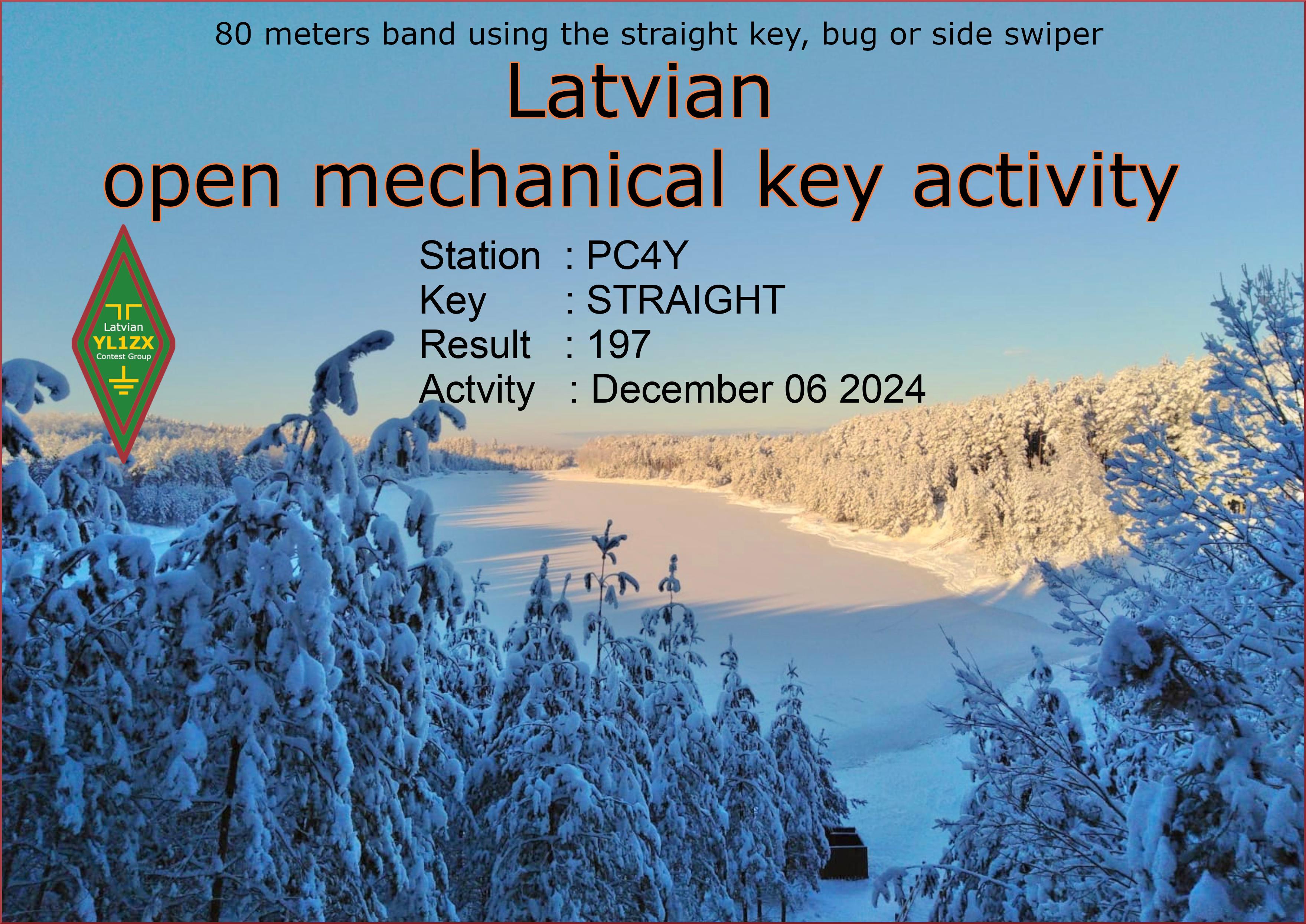
Saturday 16 November 2024. Joined the Bulgarian LZ
DX CW contest for a few hours and made 74 QSO's in the 10, 15, 20
and 40 meter bands. Lots of stations and good conditions. See map
below.
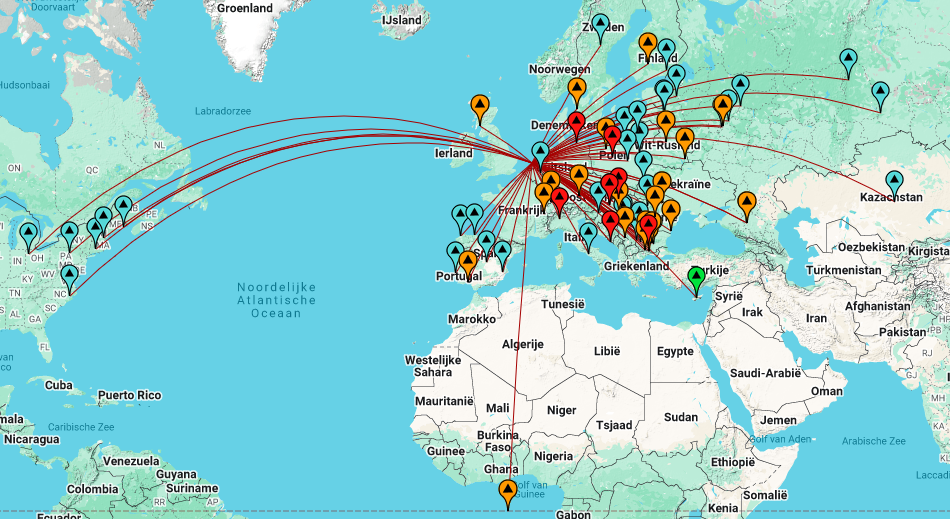
Wednesday 13 November 2024. Resolved an major issue
in the shack. When I worked the FT450 or the FT991A in full power,
both transceivers went blank. I could however work the FT7900 with
full power. By eliminating all equipment between antenna and
transceivers and between the power supply and the transceiver, like antenna switches, 12 VDC distribution panel from
MFJ, AMP meter and alike, I found a main fuse in the 12 VDC
distribution panel to make an insufficient contact with the fuse
holder. I replaced the fuse (40 amp) and cleaned the fuse holder
that showed some black burning spots. I had to open up the
distribution panel for that purpose taking all the 12 VDC leads out.
So after I had replaced the fuse and cleaned the fuse holder I had
to put the lot together again, allowing me to make some changes in
the way the transceiver power leads were routed to the distribution
panel. It made me think it wouldn't be bad idea to take the whole
shack apart every now and then and do some cosmetic changes to the
wiring and the way the equipment is placed. I think it could do
wonders to the way the shack looks.
Saturday 9 November 2024. Joined the PA Beker CW
contest. QSO's between Dutch stations only. made 60 QSO's in two
hours. It was fun again. See map below Click on the map for details.
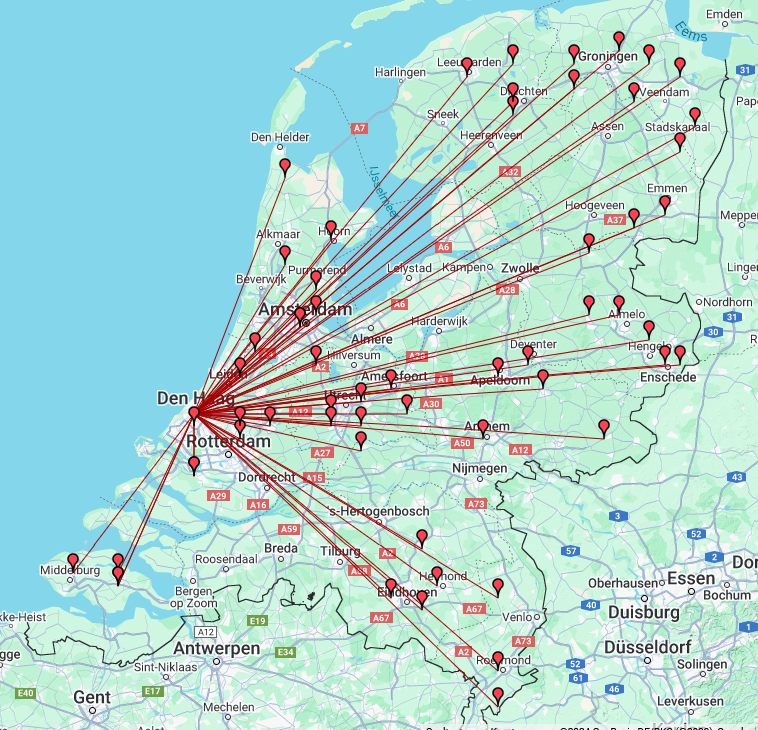
Weekend 26/27 October 2024. Joined the famous
CQWWDX SSB contest. The first time I joined an SSB contest. It was
fun though, although I was amazed by the many ways the NATO alphabet
can be pronounced :). I made 39 QSO's during the few moments I was
in the air as it were lovely sunny days inviting me to go out. See
map below for the QSO's. One with China B0A. Click on the map for
more details.
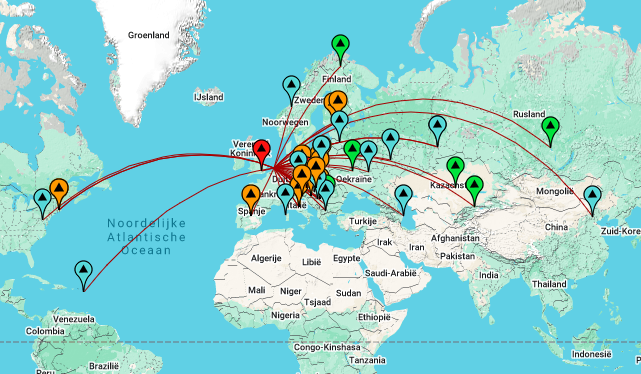
Weekend 19/20 October 2024. Joined the Worked All
Germany (WAG) contest and made 60 QSO's in the 40 and 80 meter
bands. Lots of stations and good conditions.
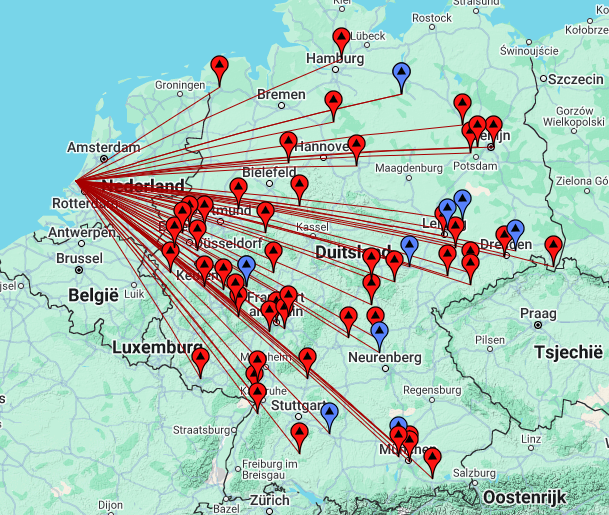
Thursday 17 October 2024. Worked the NTC QP in the
20, 40 and 80 meter band, but still only 11 QSO's. It was fun
nevertheless.
Tuesday 15 October 2024. Worked the AGCW NTC QSO
Party in the 40 meter band from 18:00 zulu till about 18:30 zulu.
Only 8 QSO's with both AGCW and NTC members.
Sunday 22 September 2024 afternoon. Worked
9J2BO on 28.045 (Zambia,
Lusaka). It was my 150th DX. Great.
Weekend 21/22 September 2024. Joined the SAC
contest. Conditions were moderate, but worked 60 stations in 3
bands.
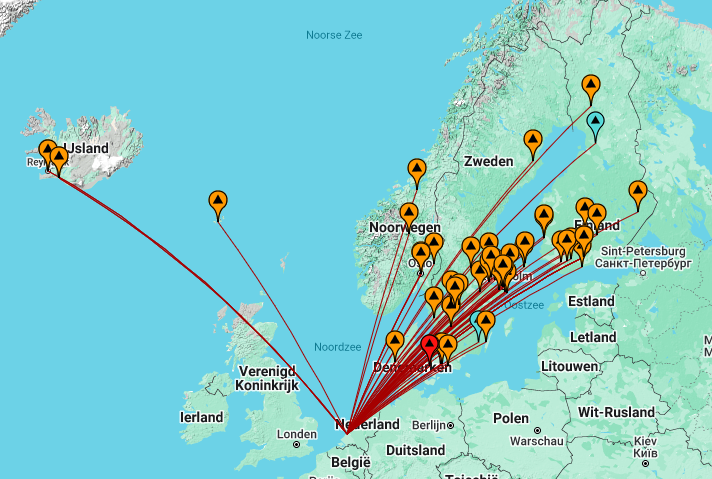
Thursday 19 September 2024. Joined the NTC QP (QSO
Party) from 19.00 - 20.00 UTC. Only worked the 40 meter band with
lots of QRM by Over the horizon radar. Tried the 20 and 80 meter
band though, but no NTC members there.
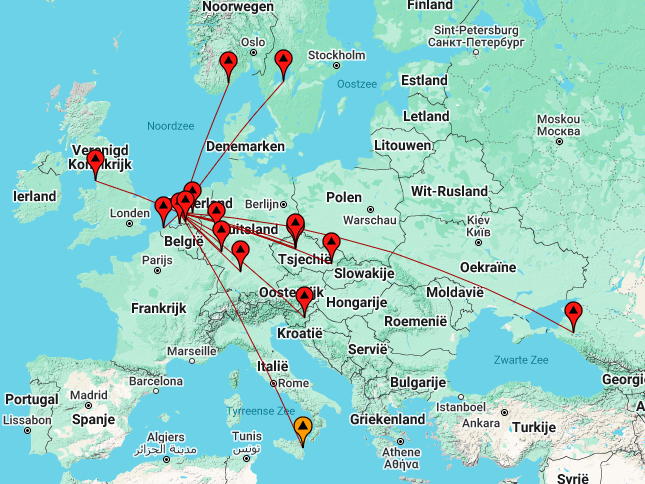
Monday 16 September 2024. Worked PA80OMG and GB80MG
as special event stations for Operation Market Garden which was 80
years ago this day today. It was busy on the 40 meter band
frequencies on which both stations worked.
Thursday 12 September 2024. Joined the Bavarian BCC
contest for some time. Only 80 meter band. Worked some German
stations with a favourable distance. Never had so much luck in the
80 meter band.
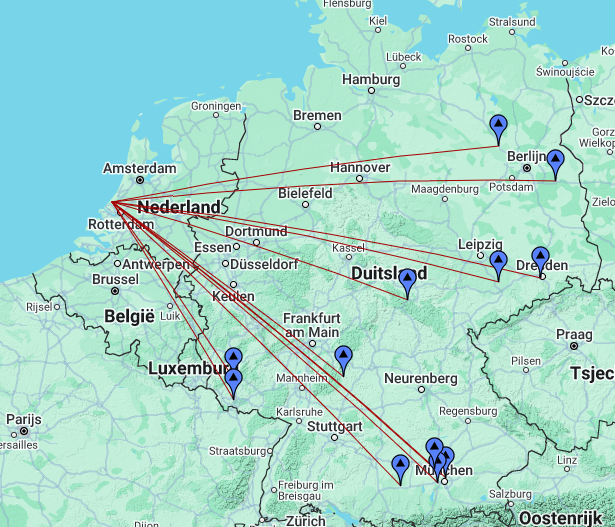
Saturday 7 September 2024. Joined the CWOps contest
for some time. Mostly 15 meter band.
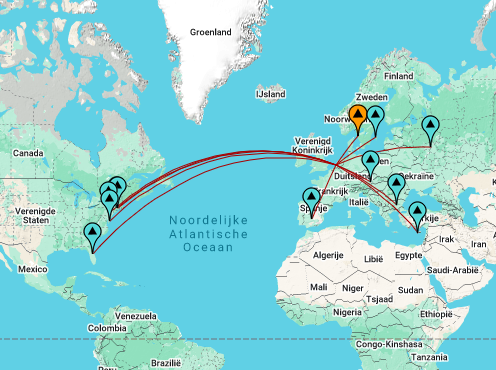
Tuesday 3 September 2024. The RSGB gave the
IOTA results with an UBN:
|
|
|
|
|
|
|
|
|
|
|
|
|
|
| 27/07/24 |
12:29 |
GM7V |
|
599 |
5 |
91
|
90
|
Serial RX Out By 1 |
|
|
| 27/07/24 |
12:59 |
HO30
|
SO3O
|
599 |
16 |
77 |
|
Broken:Callsign
|
5 QSO Points |
|
| 27/07/24 |
21:41 |
5QHW
|
5Q5W
|
599 |
32 |
264 |
|
Broken:Callsign
|
5 QSO Points |
|
| 27/07/24 |
22:04 |
M15I
|
MI5I
|
599 |
44 |
672 |
|
Broken:Callsign
|
5 QSO Points |
|
|
|
|
| 27/07/24 |
22:01 |
PC4Y |
|
599 |
297 |
43 |
|
Duplicate |
|
5Q5W |
| 28/07/24 |
08:29 |
PC4Y |
|
599 |
584 |
155
|
55
|
Broken:Serial RX
|
|
HA6NL |
|
QSO Error rate =
4.92% Average Error Rate for this contest = 4.23% |
Weekend 24/25 August 2024. The Romanian (YO)
contest from 12.00 zulu till 12.00 zulu. I worked the 10,15, 20, 40
and 80 meter bands and worked 75 stations. I only worked three hours
in total. Only a few real DX, otherwise mostly Europe. Click on the
map below for more details
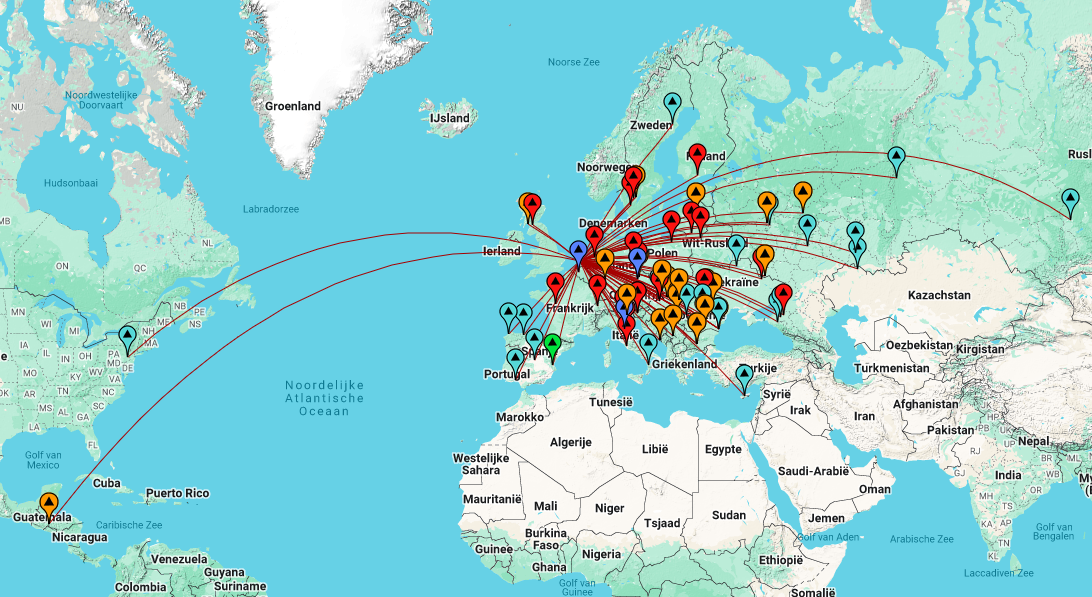
Saturday 3 August 2024. EUHFC contest. Only
European stations working one another. Made 62 QSO's. In the 15, 20
and 40 meter bands. Fine connditions.
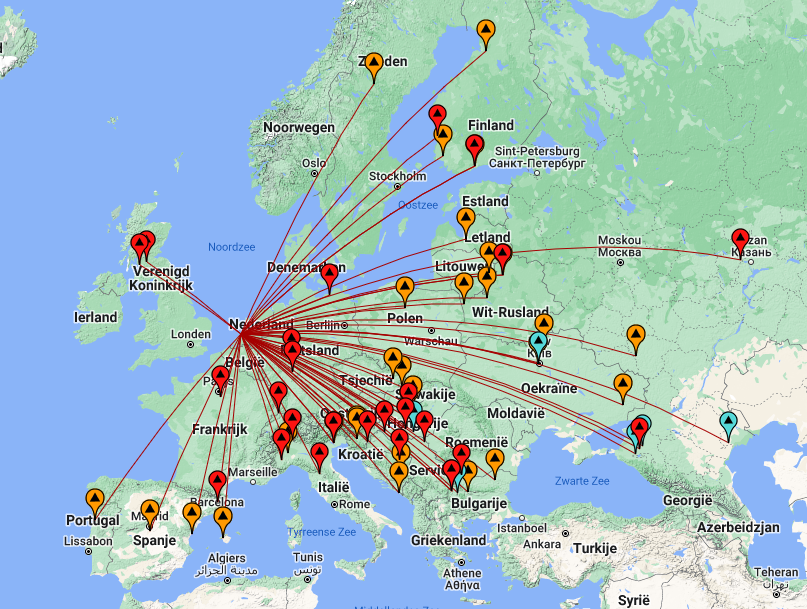
Weekend 27/28 July 2024. The famous IOTA contest. I
made 61 QSO's. Great fun
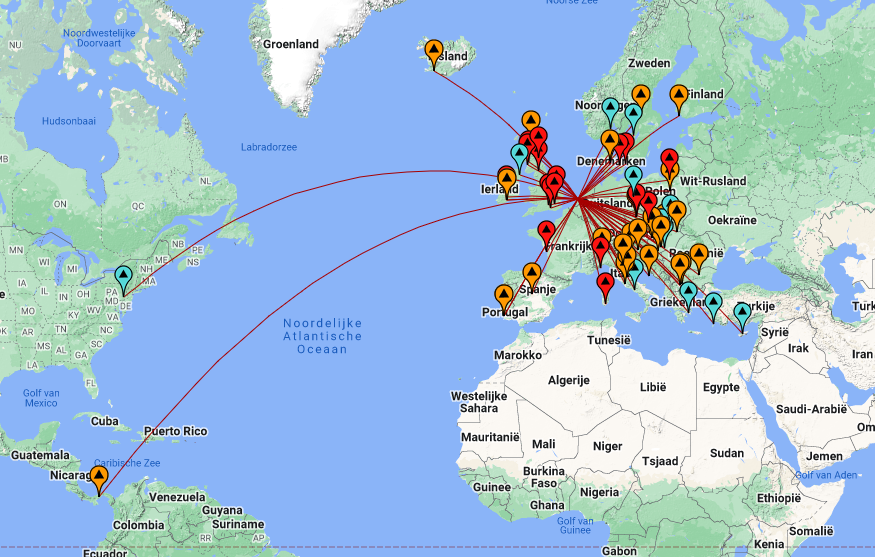
Saturday 6 July 2024. Joined the Marconi Memorial
Contest (MMC). Unfortunately only for a few brief moments due to
family visits. So I only made 25 QSO's. In de 15 and 20 meter bands.
Lots of activity. The log was uploaded successfully.
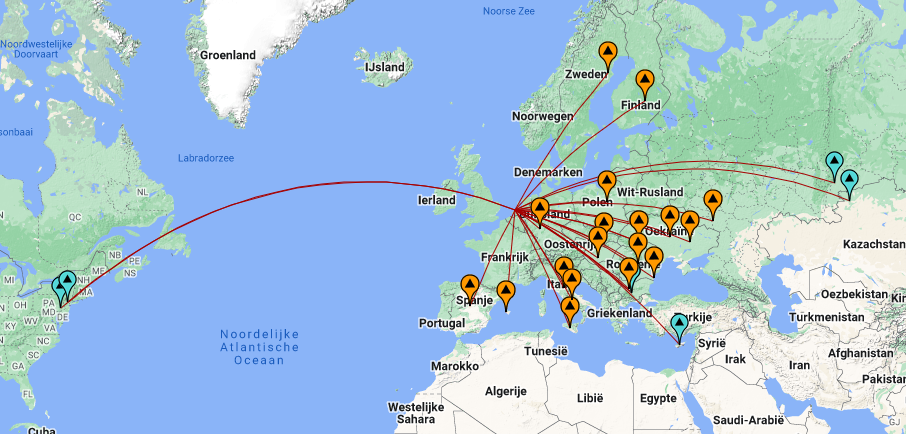
Tuesday 2 July 2024. ARRL informed me that LOTW was
back on line since well over one month. So I uploaded my logs from
May onwards successfully.
Monday 1 July 2024. Tried to work the Canadian RAC
Canada Day contest. But conditions were poor, so I only made five
QSO's and only one with Canada.
Tuesday 18 June 2024. The results came in from the
King of Spain contest:
|
Call |
Category |
Claimed |
QSO |
Valid |
Points |
Mult. |
Total |
|
PC4Y |
SINGLE-OP ALL LOW DX |
2,448 |
50 |
45 |
59 |
30 |
1,770 |
Weekend 25/26 May 2024. The (in)famous CQ WPX CW
contest running for 48 hours. I picked an hour here and there and
stopped when I had made 200 QSO's late Sunday evening. I came across
fellows who had made over 4,500 QSO's. Holy moly. I worked mostly
Europe, but also US, Canada, Brazil and Cape Verde. Conditions
seemed fair. And I worked all the bands except 80 and 160 meters.
See map below for more details.
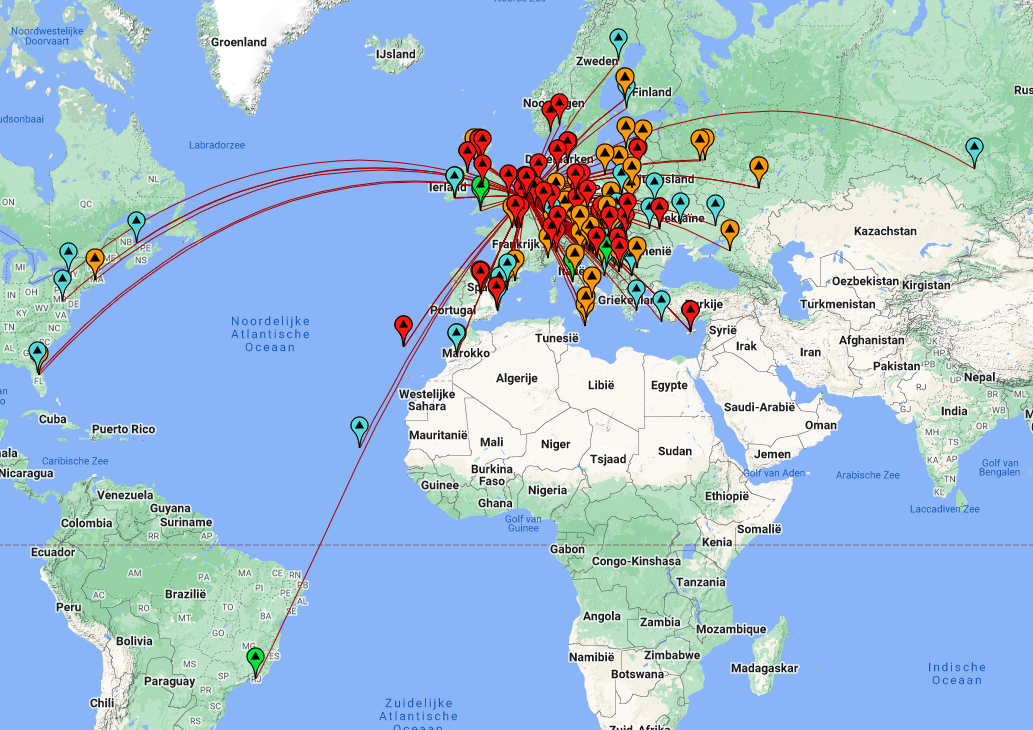
Saturday 18 May 2024. Joined the King of Spain
(KOS) contest every now and then until I had 50 QSO's in the 15, 20
and 40 meter bands. Conditions were moderate.
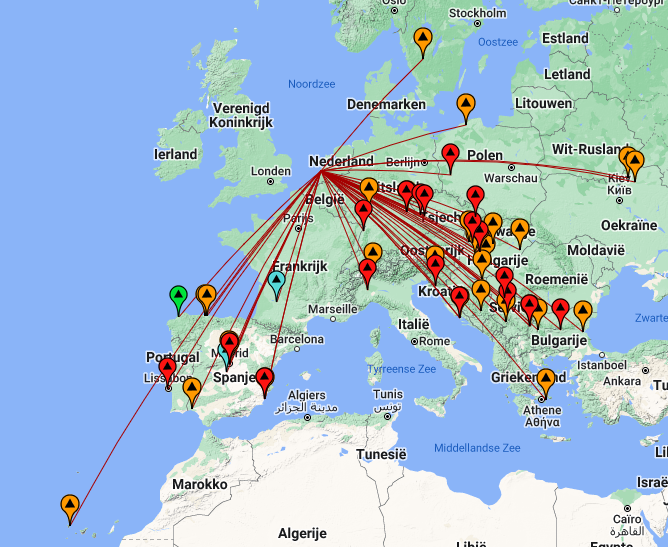
Weekend 11 and 12 May 2024. The EUDXCW contest
results came in. The award can be found at the bottom in the right
column on this page.
Saturday 20 April 2024. Joined the YU contest from
Serbia, but there were too many conflicts with the MM, WSEM and the HL
contest all at the same time. And some contesters didn't say for
which contest they were on the air. Unfortunately one cannot
participate in more than one contest at the time if using the N1MM
logging programme. So I called it quits after 14 QSO's. Somewhat
later I started to participate in the MM contest and made 36 QSO's
including SA, NA, AF and AS regions. Click on the map for more
details.

Thursday 18 April 2024. NTC QP (QSO Party) from
19:00 - 20:00 zulu. All of a sudden my N1MM logging programme
stopped working saying I have to reinstall. Shit happens, but after
15 minutes I was back in the air. In total only 17 QSO's in de 40
meter band. Click on the map below for full info.

Tuesday 16 April 2024. Joined the AGCW/NTC
friendship QSO party. I stopped when the thunder hit our spot but
still made 13 QSO's

Sunday 14 and Monday 15 April 2024. Participated in
the Maritime Radio Days (MRD) where former radio officers contact
one another in HF exchanging info about former ships and/or coastal
radio stations where they have been working on. Conditions were poor
for DX, so I only worked Europe in the 20 and 40 meter bands. Both
from home as PC4Y and from the ss Rotterdam/PHEG as PI4HAL. In total
some 50 or so stations were worked with. It was fun again. And there
were many stations I worked with in the past.
Saturday 6 April 23024. DARES field exercise named
Last Mile. Nationwide field test. Participated from home and
worked the field stations in the county. National coordination PI9D
at 7115 kHz. Operator Louis. Worked him to. It was good to test the
coverage in the county (Haaglanden/Hollands Midden). It turned out
that coverage needs improvement. Work in progress.
Thursday 21 March 2024. Joined the NTC QSO Party.
But got called away after 15 minutes. So it is a short list of only
11 QSO's in the 40 meter band with my Yaesu FT-450. See map below.
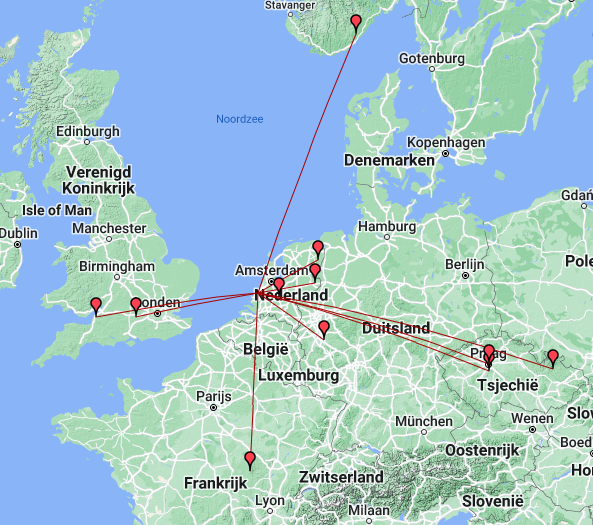
Sunday 10 March 2024. Joined YOTA for one hour or
so. Made 21 QSO's. The youngest was 14 years of age, the eldest was
83 years of age. Great to hear so many stations participating.
|
Evaluation category |
QSOs |
Points |
Multipliers |
Claimed score |
|
Single
Operator 3 bands |
21 |
54 |
19 |
1026 |
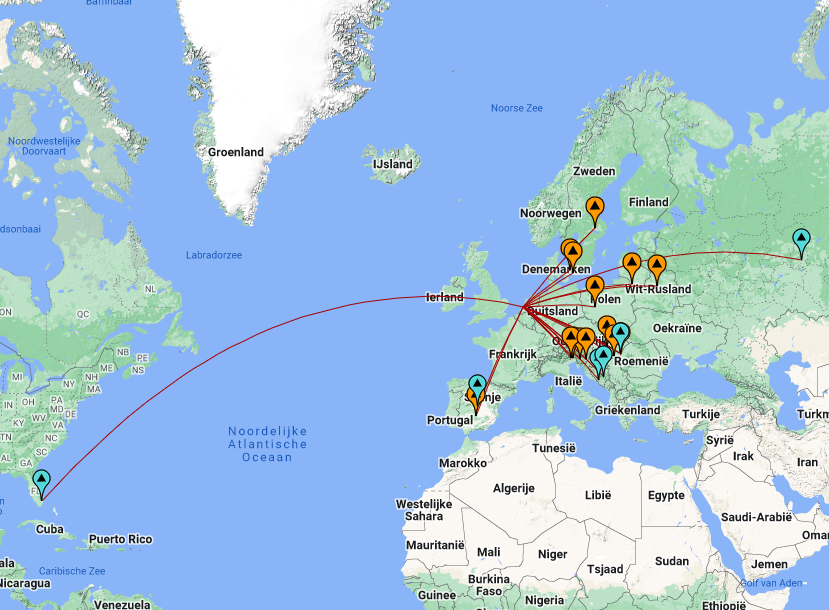
Weekend 24/25 February 2024. UBA CW contest. Many
participants. Busy and open bands. It was nice, although I only
worked Europe for some reason. And I had to quit as I had unexpected
transmission problems. They appeared both on the FT-450 and the
FT-991A, so I assume it must be an antenna problem or tuner issue.
But even when I bypass all of the cables and switches between
transceiver and antenna the problem still exists. It is an
intermittent problem, so it is kind of difficult to tackle. Click on
the map below to get the full info. So I only made 72 QSO's.
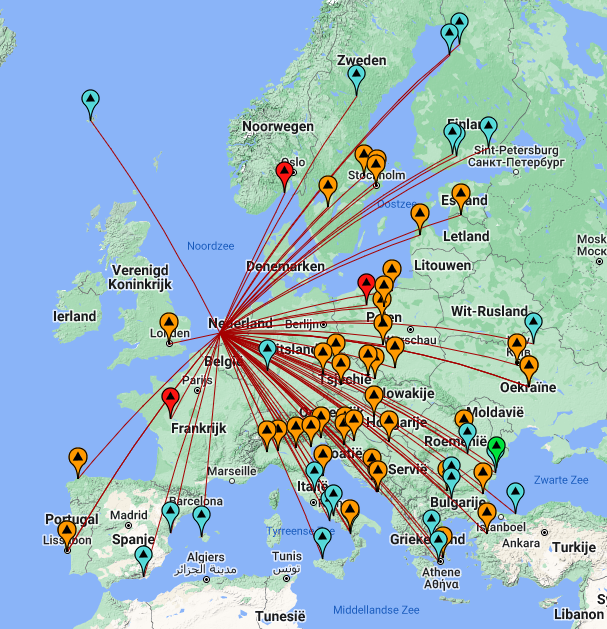
Weekend 17/18 February 2024. ARRL DX contest. Only
US/Can stations. I only worked 24 stations as there were just to
many other things to do this weekend.

Thursday 15 February 2024. NTC QSO Party during one
hour. Made 26 QSO's. Was busy in the band (40 mtrs)
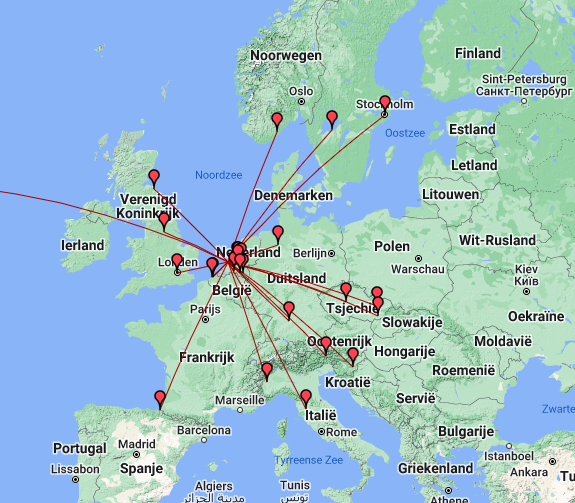
Weekend 10/11 February 2024. Joined the PACC
contest in CW mode. Made 260 QSO's; an all time high for me in one
contest. Worked the 10, 15, 20 and 40 meter bands. It was fun and
exhausting :) . See map below. Click on the map to get the full
picture. It again became apparent that when sending out the CQ
yourself, the results are much better than when you respond to a CQ
(quantity wise that is)
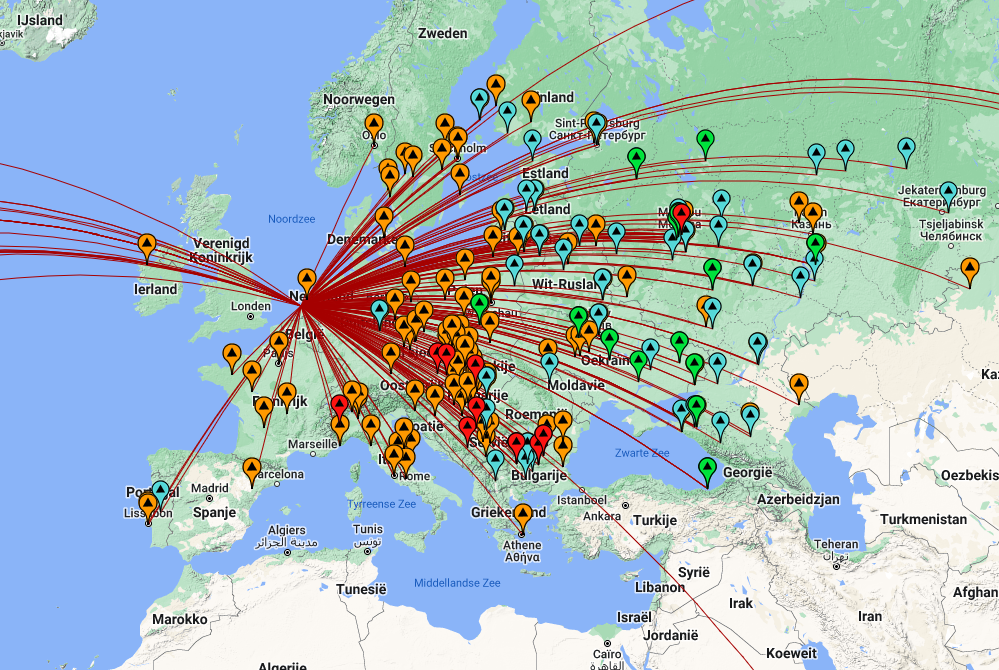
Callsign: PC4Y
Category: SINGLE-OP ALL LOW CW
Band Qso Cancelled Dup Point Penalty Mult Score
160M 0 0 0 0 0 0
80M 0 0 0 0 0 0
40M 16 0 0 16 0 14
20M 148 0 0 148 0 34
15M 73 0 0 73 0 17
10M 23 0 0 23 0 4
-----------------------------------------------------------------
260 0 0 260 0 69 0
Weekend 3/4 February 2024. Joined the EU-DX contest
and worked 58 stations in the 15, 20 and 40 meter bands. CW only.
Ended #387 in the SOAB category.
|
Evaluation category |
QSOs |
Points |
Multipliers |
Claimed score |
|
Single
Operator All Band CW Low Power |
58 |
534 |
79 |
42186 |
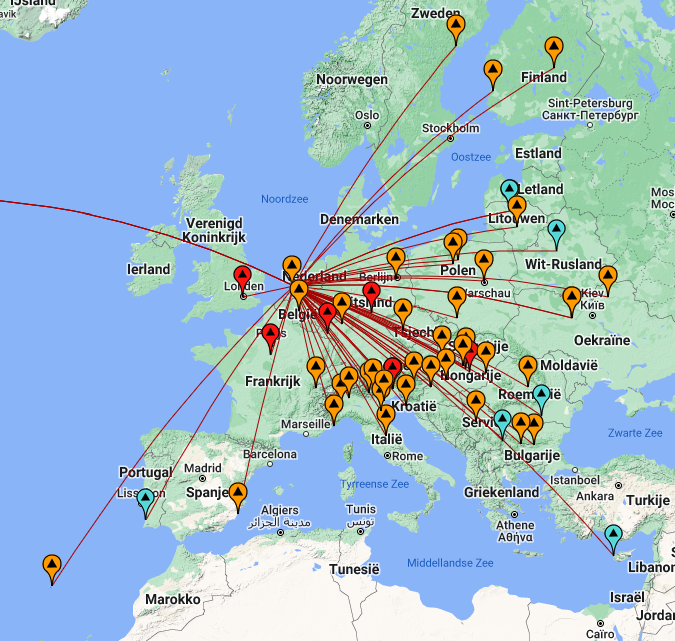
Weekend 27/28 January 2024: Firstly resolved an
unpredictable error with the transmissions: the transceiver went
blank during key-down and came back to live when key-up. After
deduction through reduction (bypassing of all interconnecting
cables, auto-tuner, switches etc.) it turned out the coax connector on the
antenna cable was faulty. So the antenna cable was replaced as I
couldn't quickly fix the connector. Then I joined the French REF
contest and worked all the bands including the 80 meter band. Liked
to be able to work Martinique and French Guyana. Also heard New
Caledonia, but they didn't hear me unfortunately. See map below. You
may expand the map by clicking on it. Worked 61 stations in total
during Saturday afternoon, evening and Sunday morning for a few
hours only.
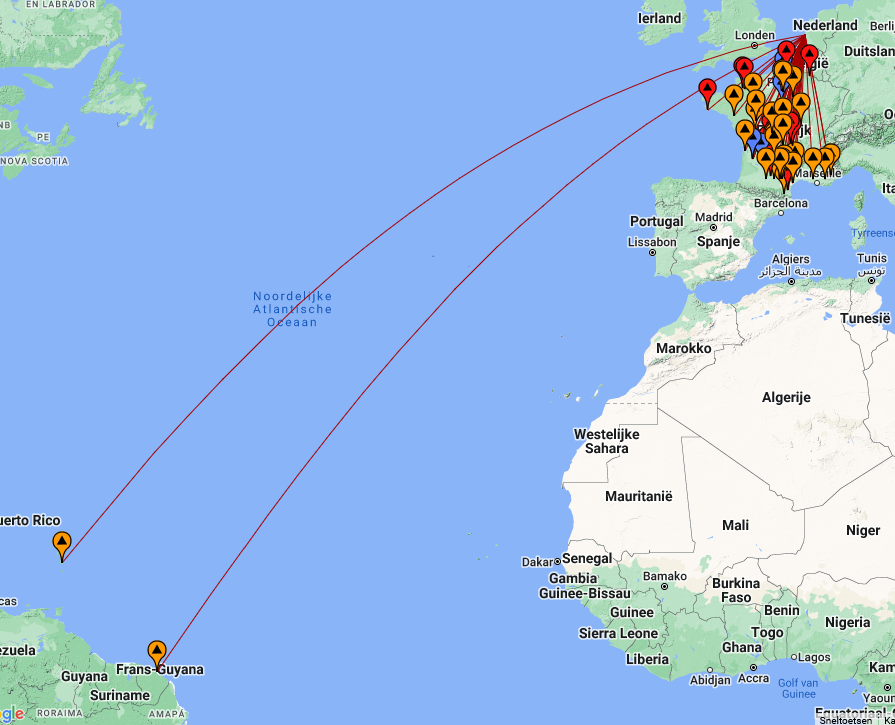
Weekend 20/21 January 2024. Joined the HA-DX
contest here and then totalling 100 QSO's in the 10, 15, 20 and 40
meter bands. All of a sudden my xmitter went blank in the 15 meter
band. Reducing the xmit power to 60 watt kind of solved the problem,
but I assume it is an antenna issue that needs investigating on a
later moment.
|
Evaluation category |
QSOs |
Points |
Multipliers |
Claimed score |
|
Single
Operator All Band CW Low Power |
100 |
507 |
66 |
33462 |
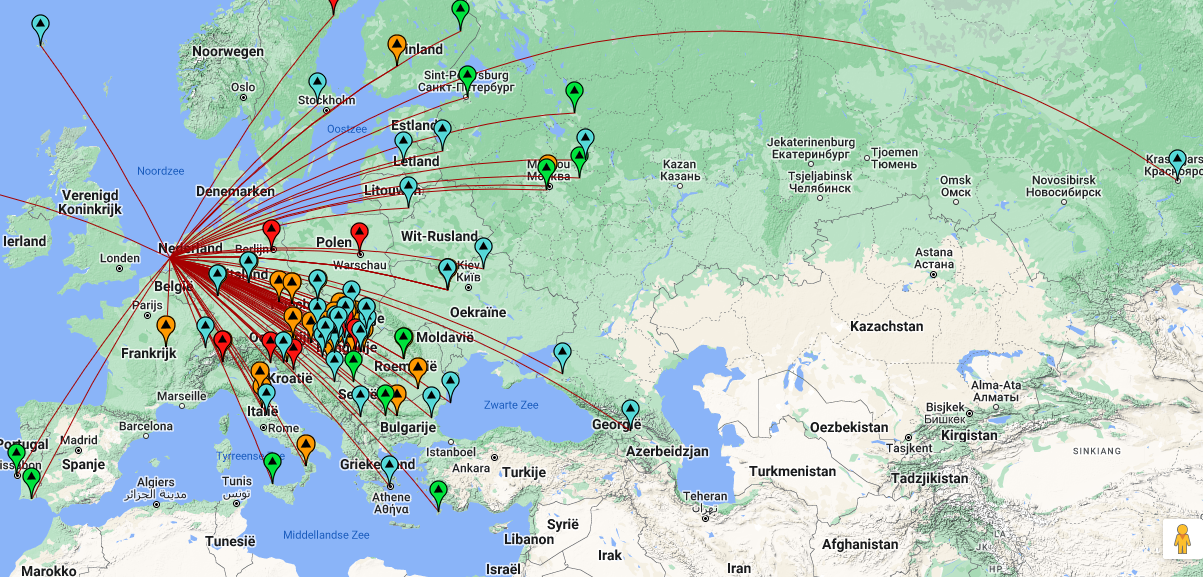
Thursday 18 January 2024. Joined the NTC_QP event,
but only made 3 QSO's in the 40 meter band due to poor conditions.
Didn't hear thing on the 80 meter band.
Sunday 14 January 2024: Joined the DARC 10 meter
contest for approx 1 hour. And added one DX: Saudi Arabia
HZ1HZ. All other QSO's
were mainly within Europe.
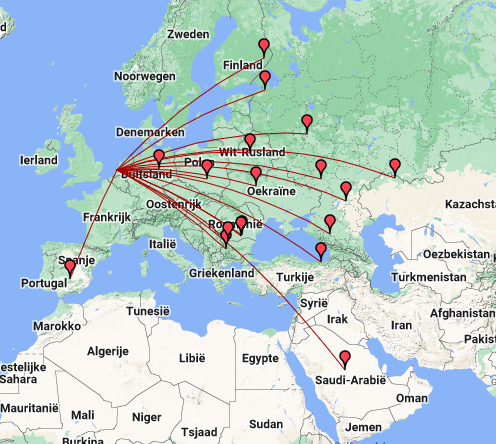
Band QSOs Pts Mul Mul2
160m 0 0 0 0
80m 0 0 0 0
40m 0 0 0 0
20m 0 0 0 0
15m 0 0 0 0
10m 18 18 0 9
Summe 18 18 0 9 ==> 162
Friday 12 January 2024: Received an e-mail from
ARRL about the validity of my TQSL certificate which ends on Jan.
31. So I had to update my certificate and could follow the
instructions. My updated TQSL is now valid for an additional 3
years.
The ARISS tracker
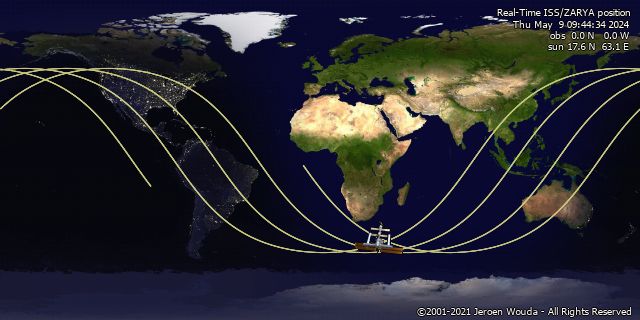
Real time tracker
The following frequencies are currently used for Amateur Radio ISS
contacts (QSOs): Voice and SSTV
Downlink: 145.800 (Worldwide)
Voice Uplink: 144.490 for ITU Regions 2 and 3
(The Americas, and the Pacific and Southern Asia)
Voice Uplink: 145.200 for ITU Region 1 (Europe, Russia and Africa)
VHF Packet Uplink and Downlink: 145.825
(Worldwide)
UHF Packet Uplink and Downlink: 437.550
UHF/VHF Repeater Uplink: 437.800
UHF/VHF Repeater Downlink: 145.800
Get to know the space station |
